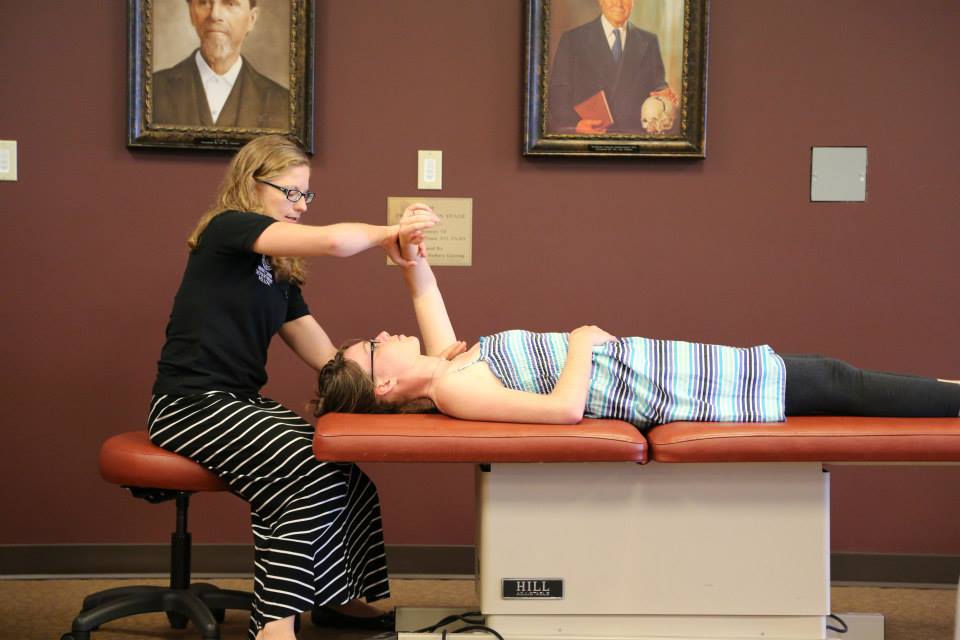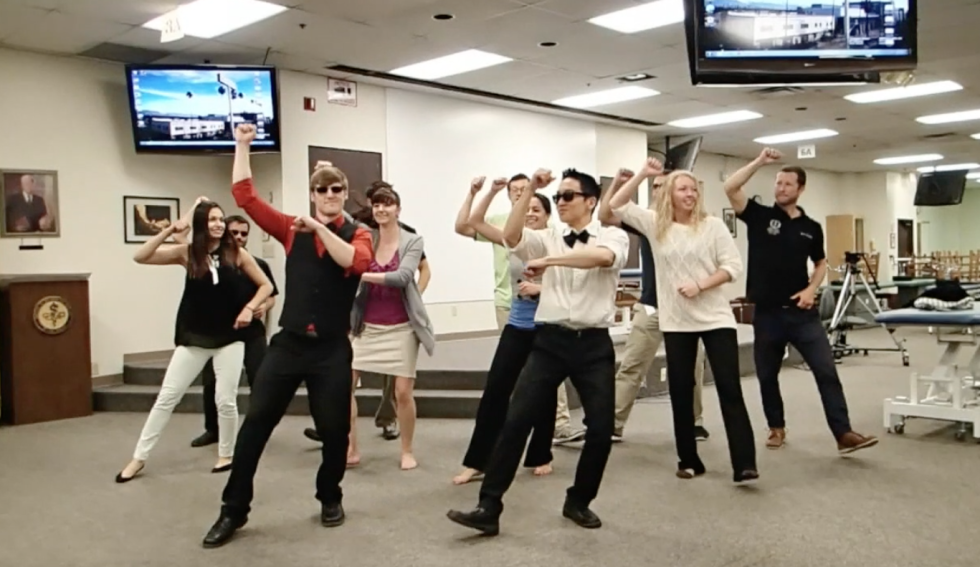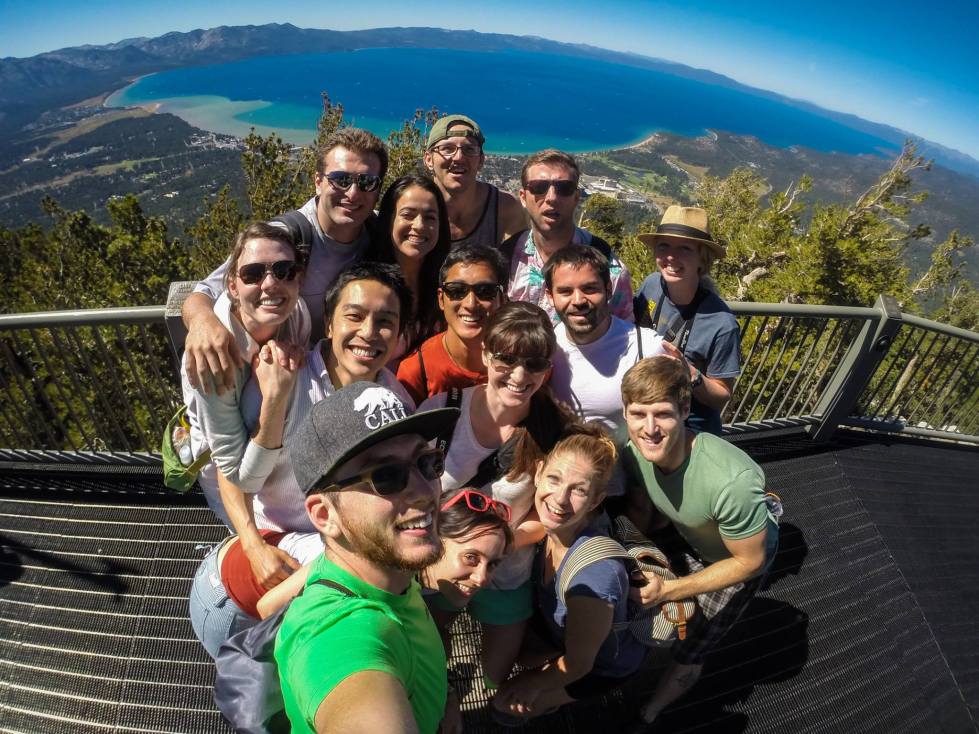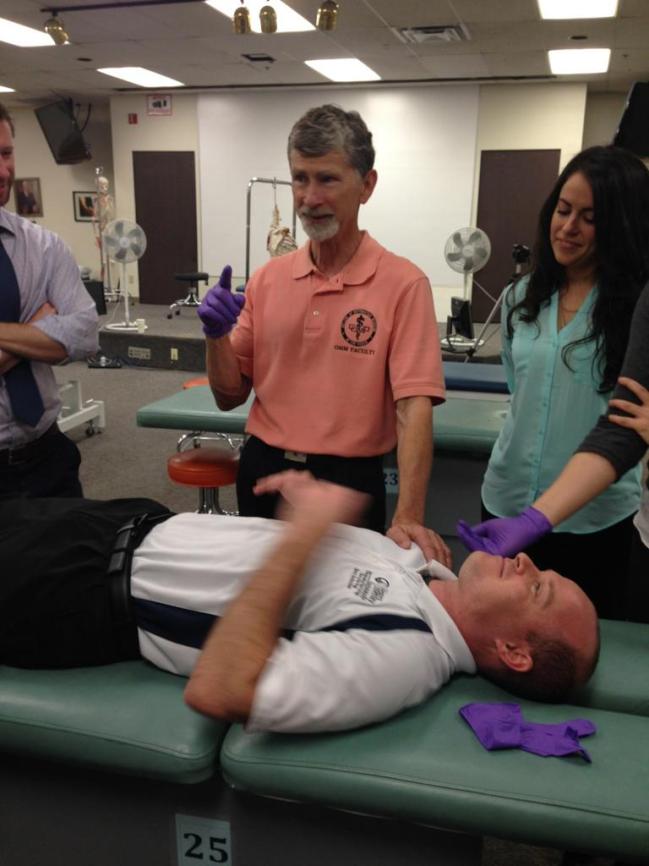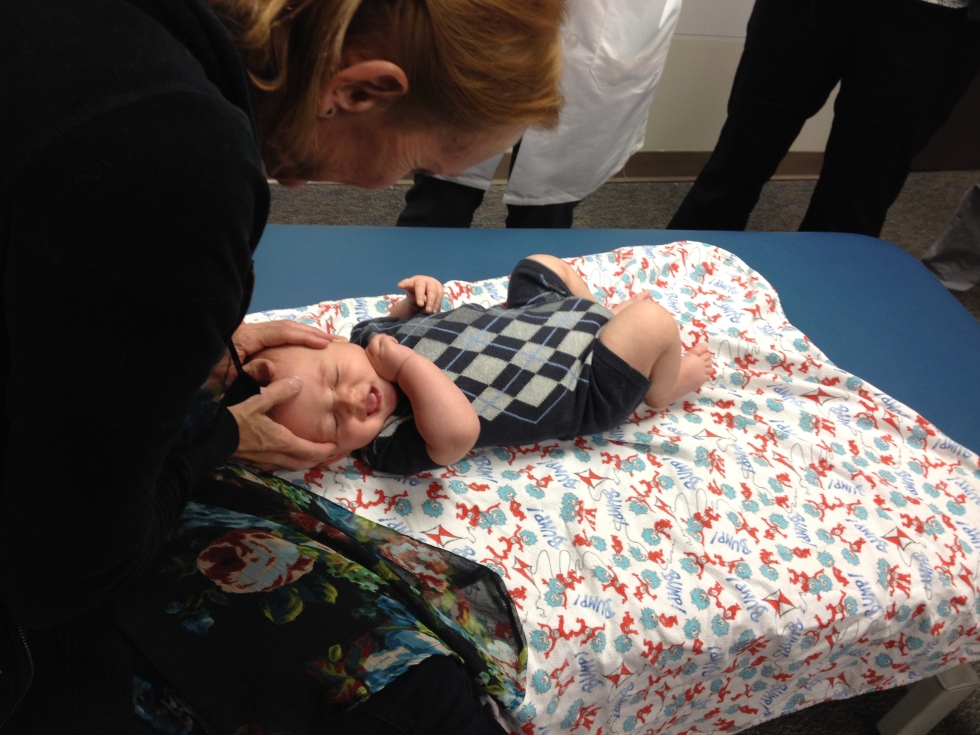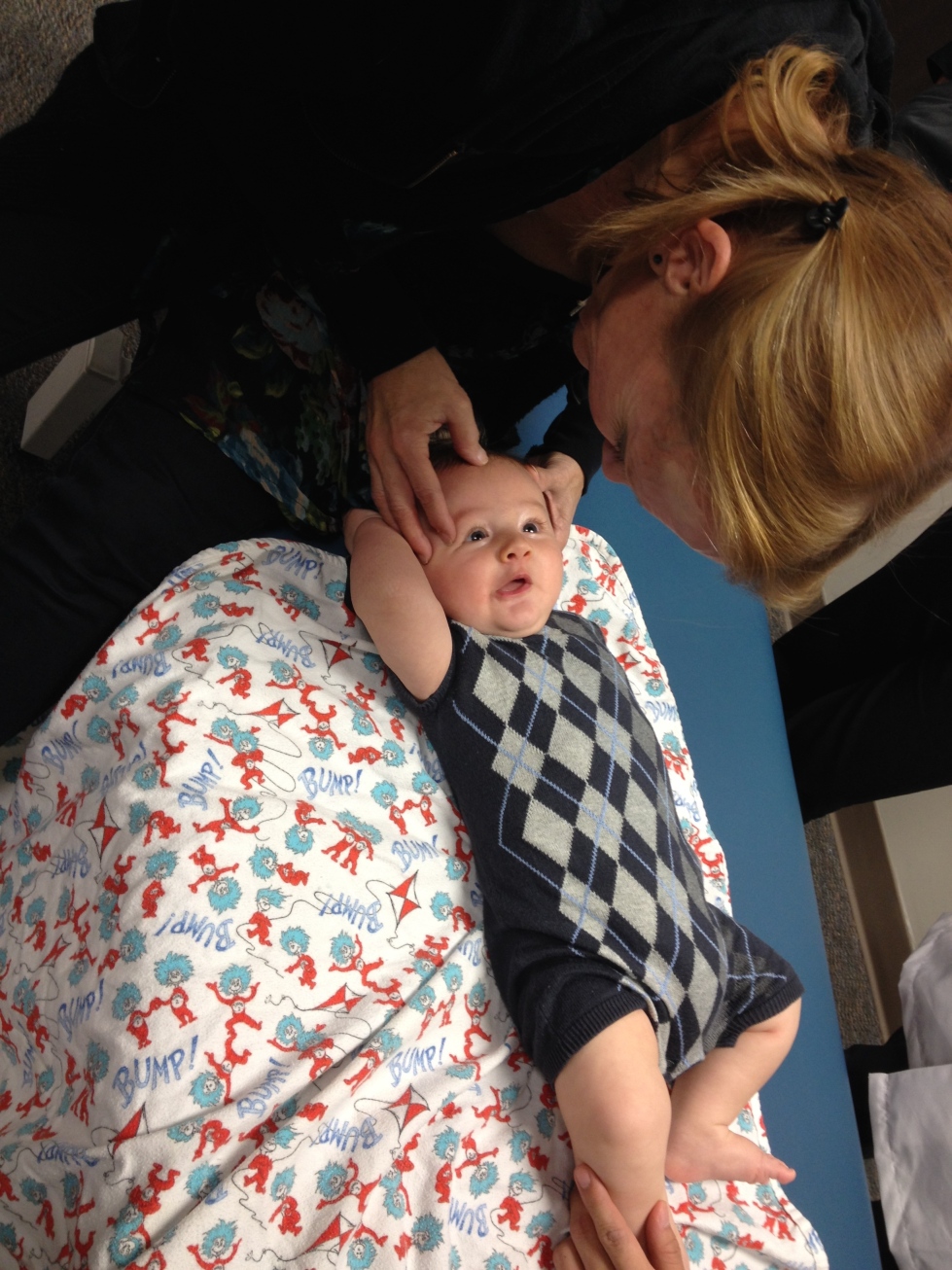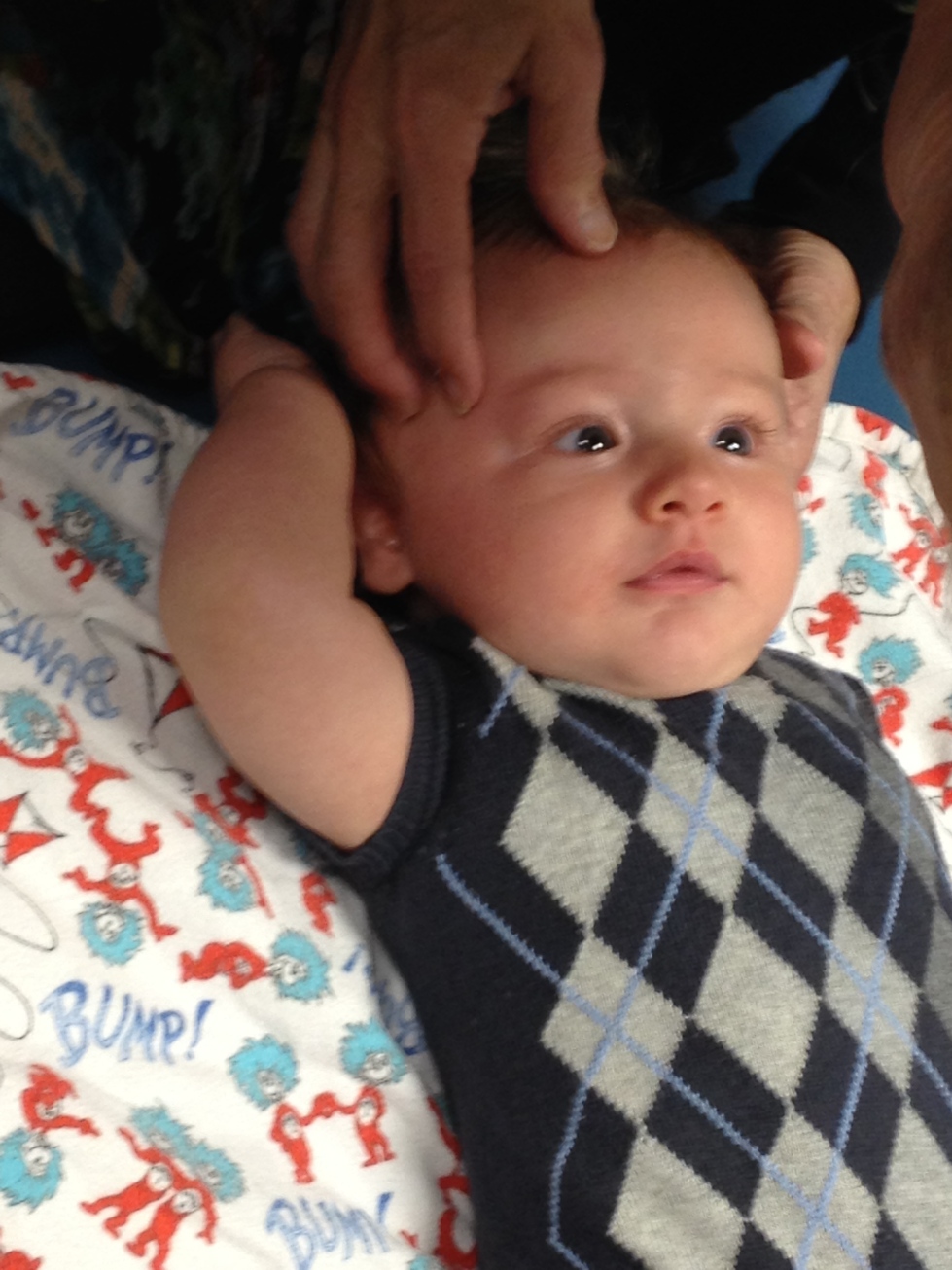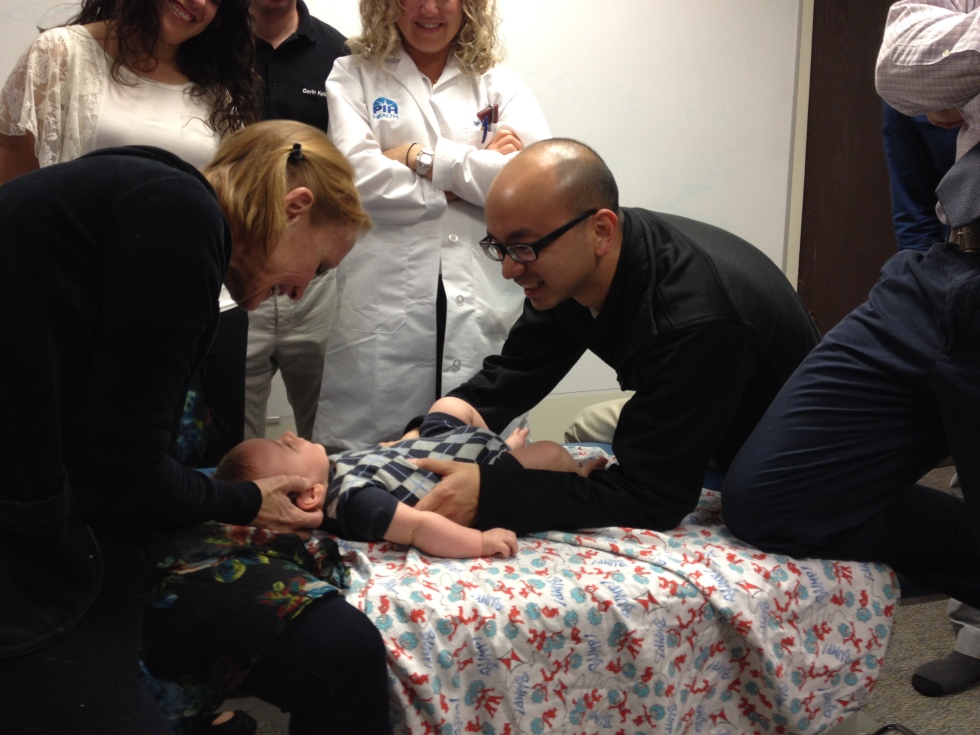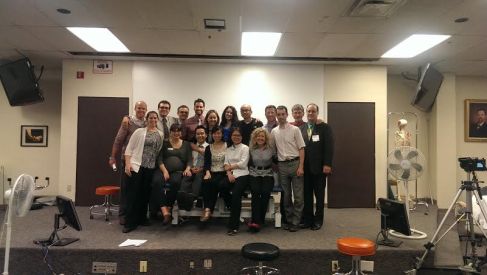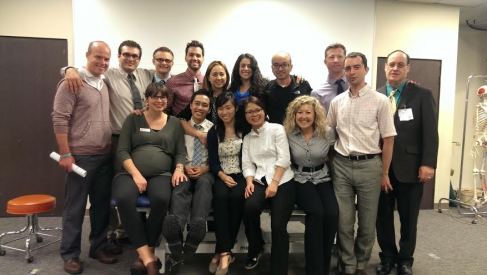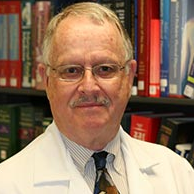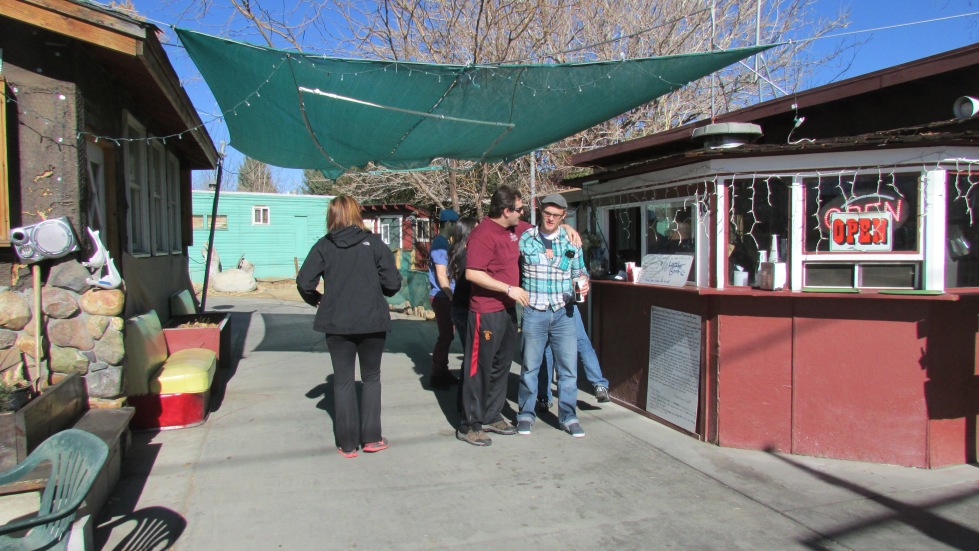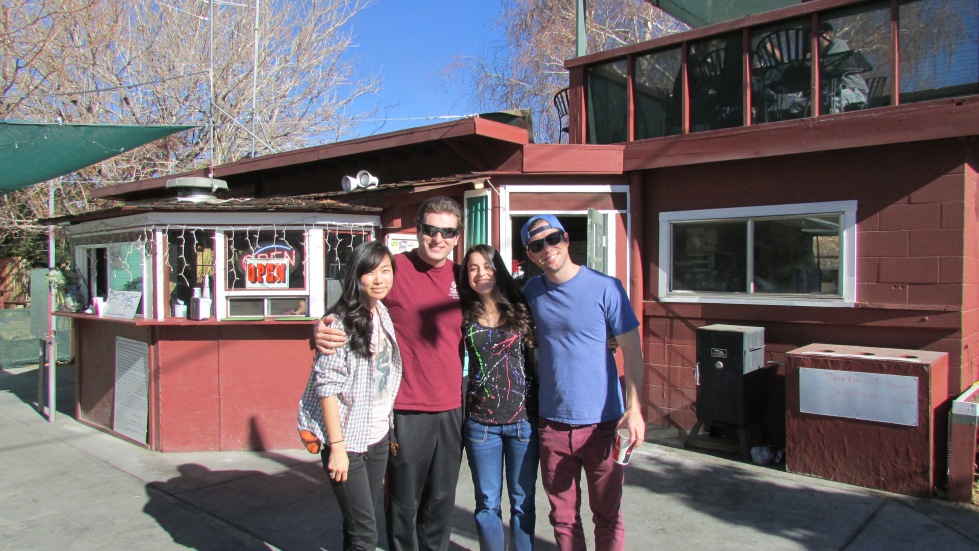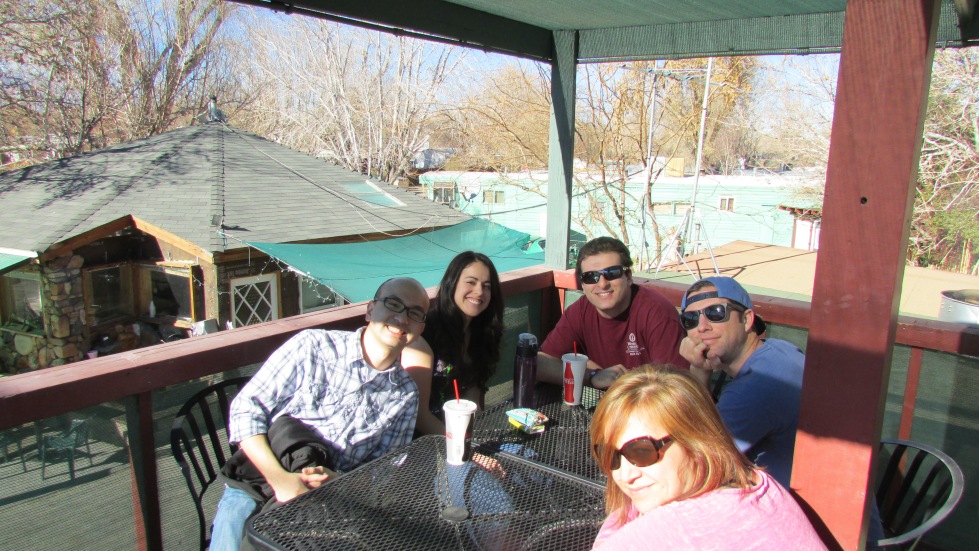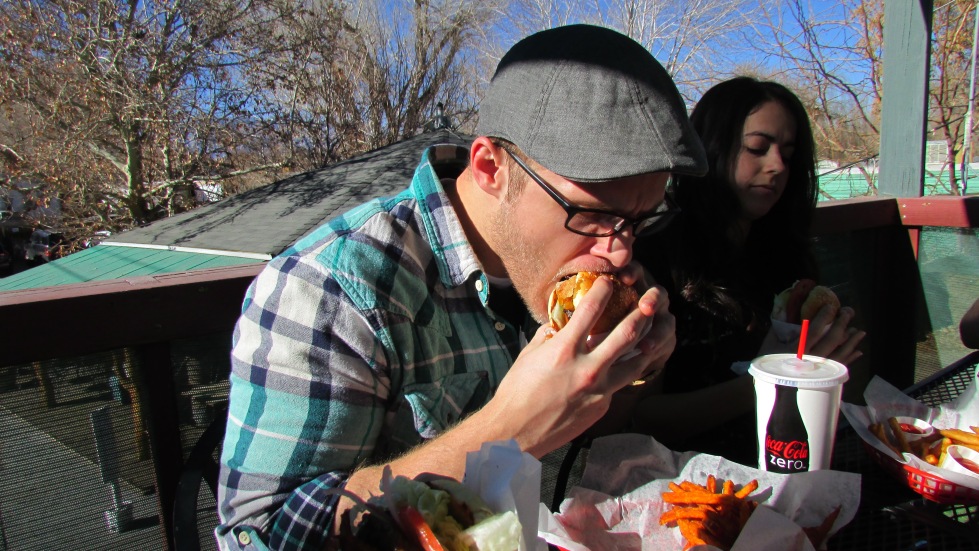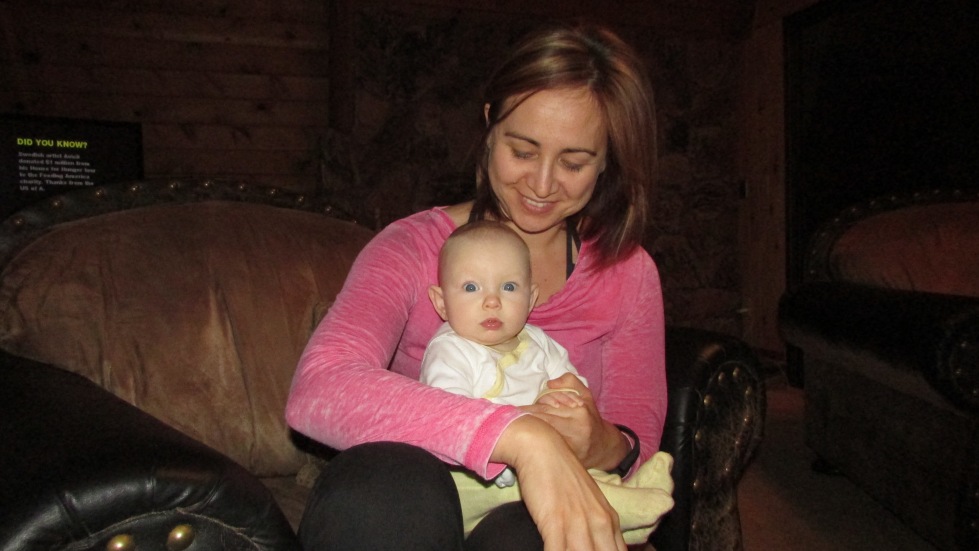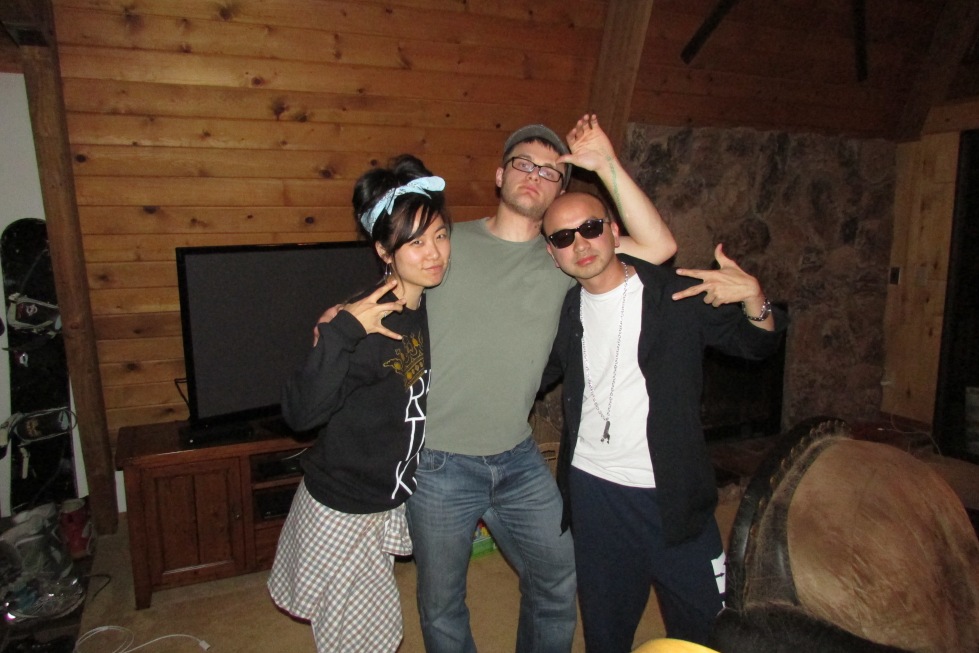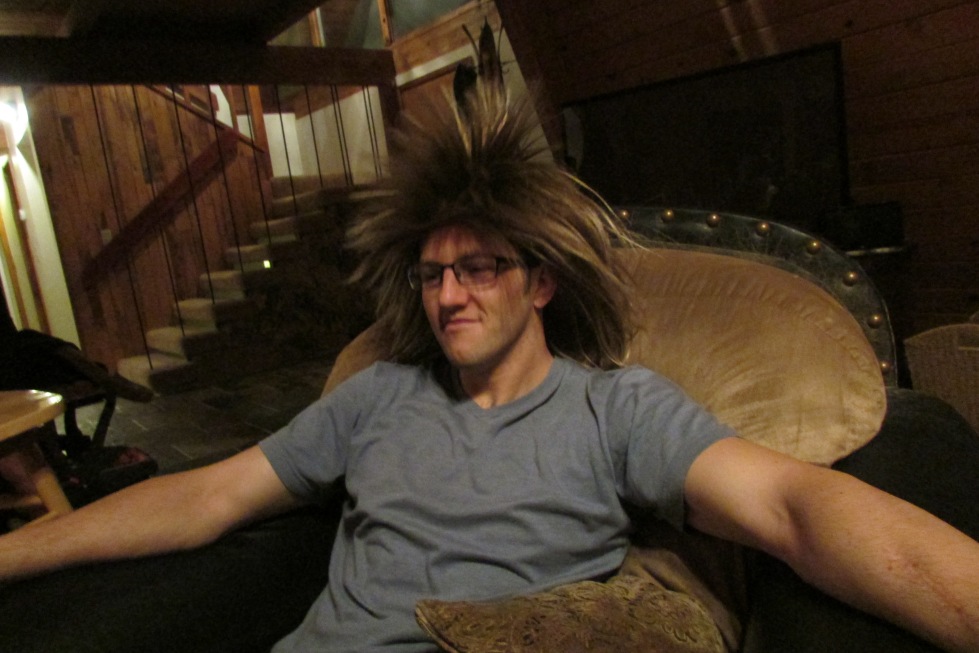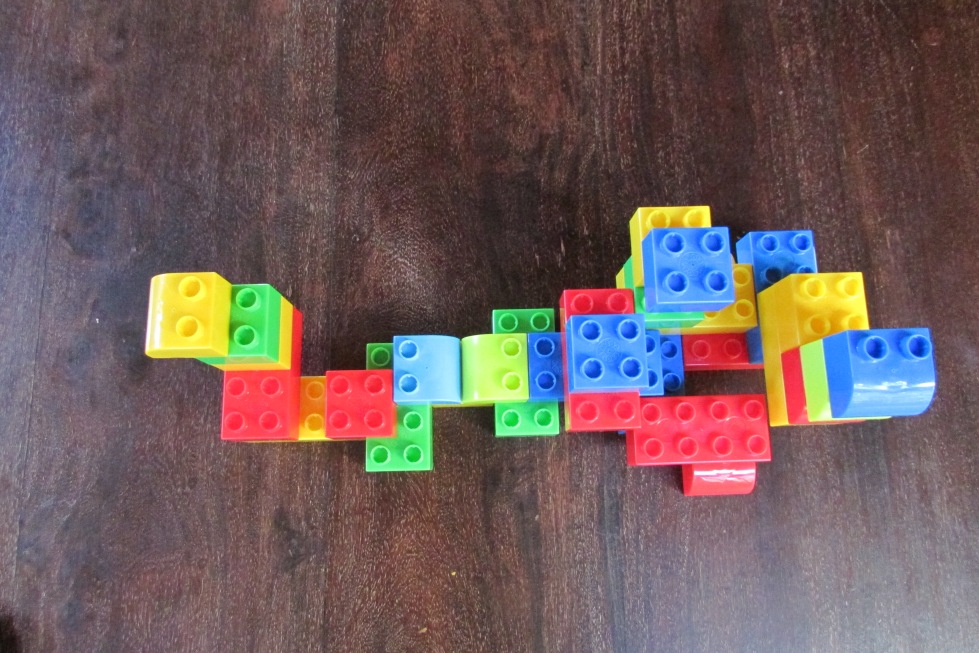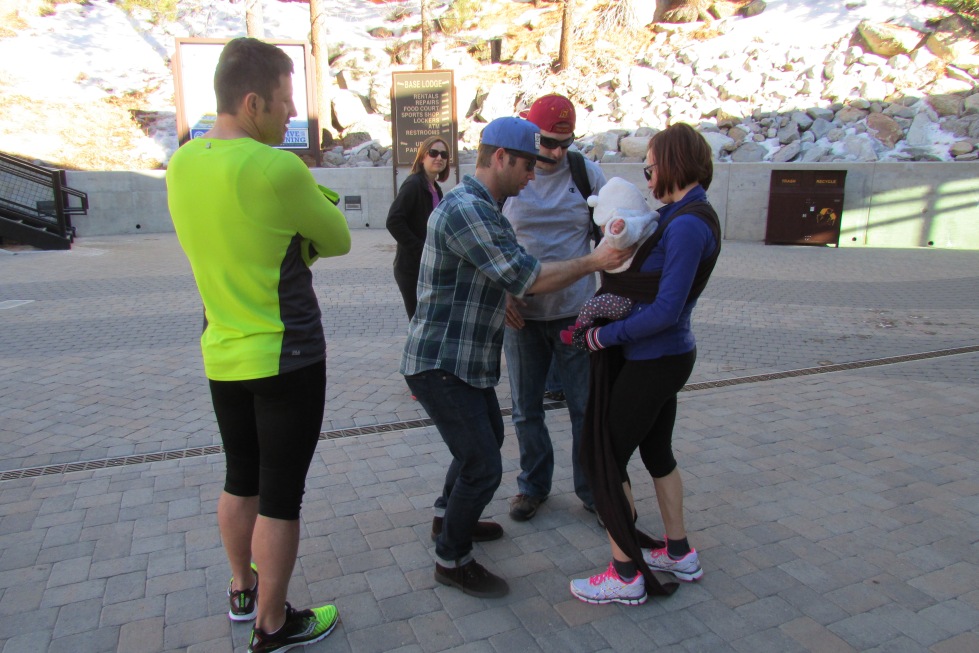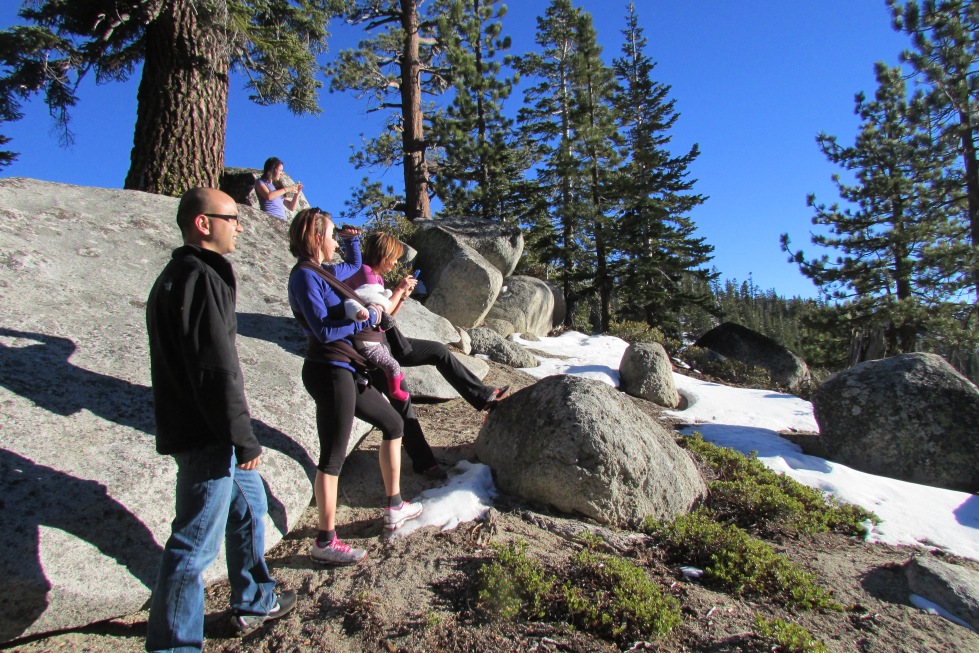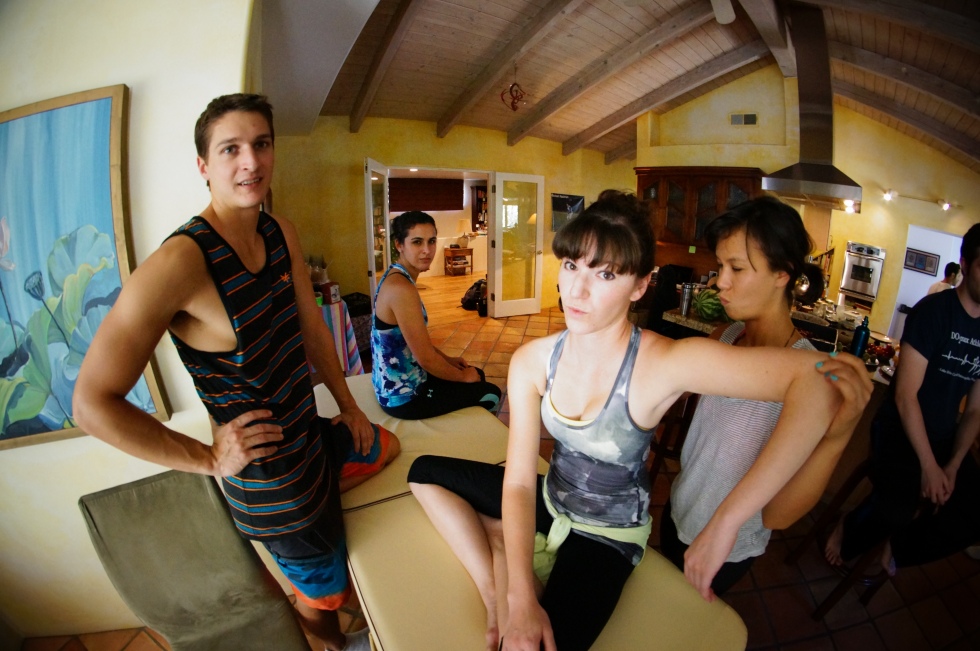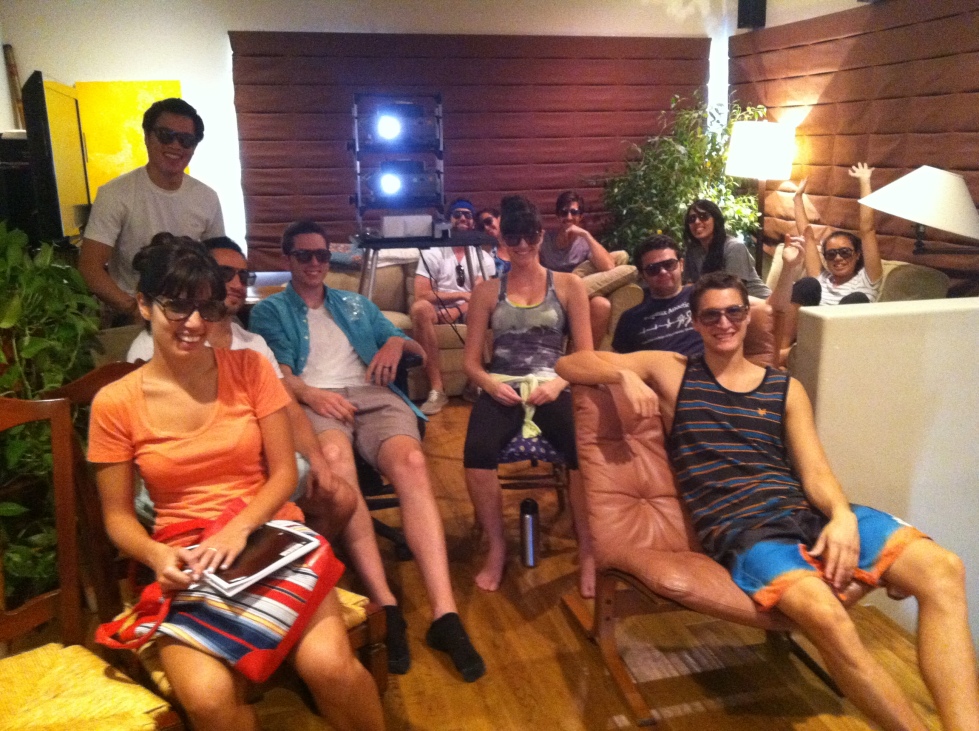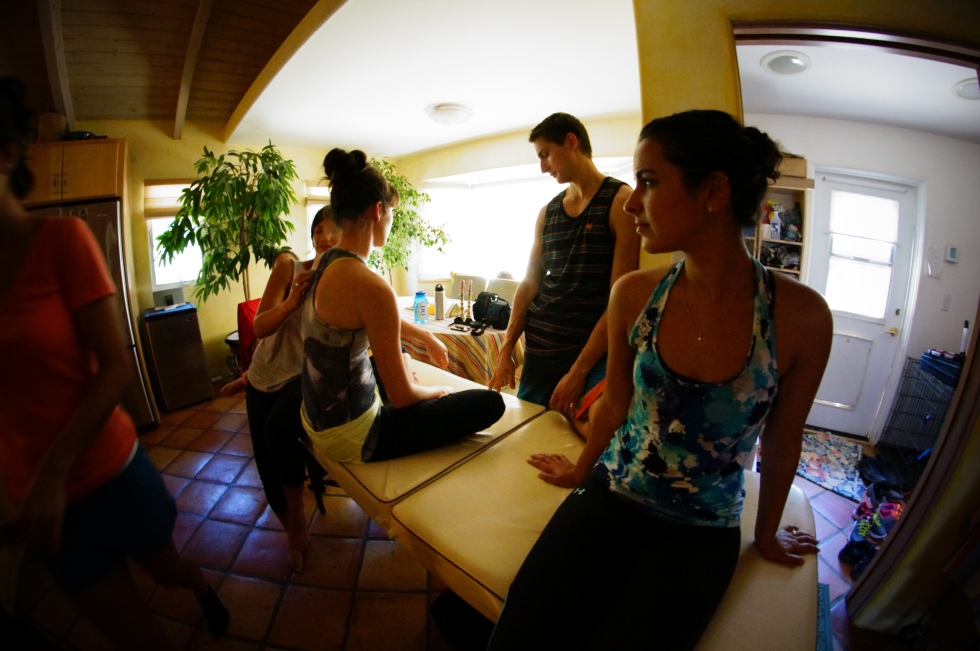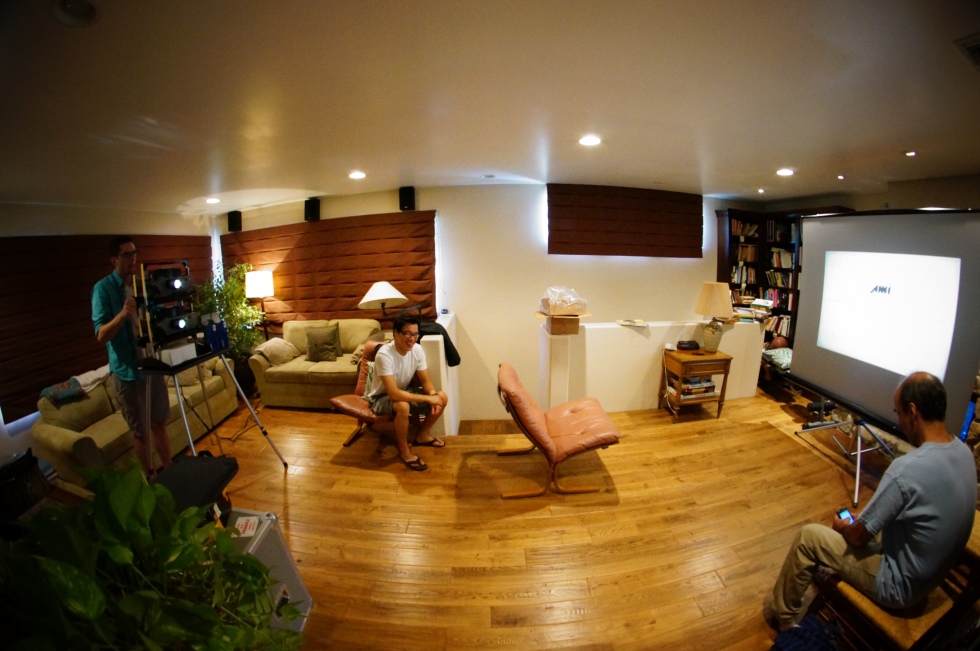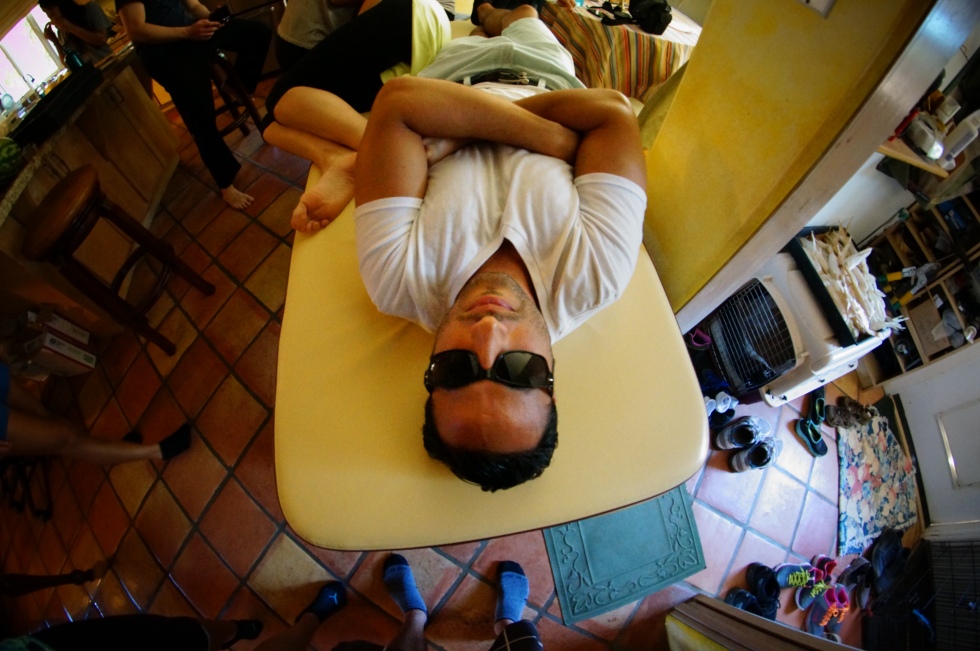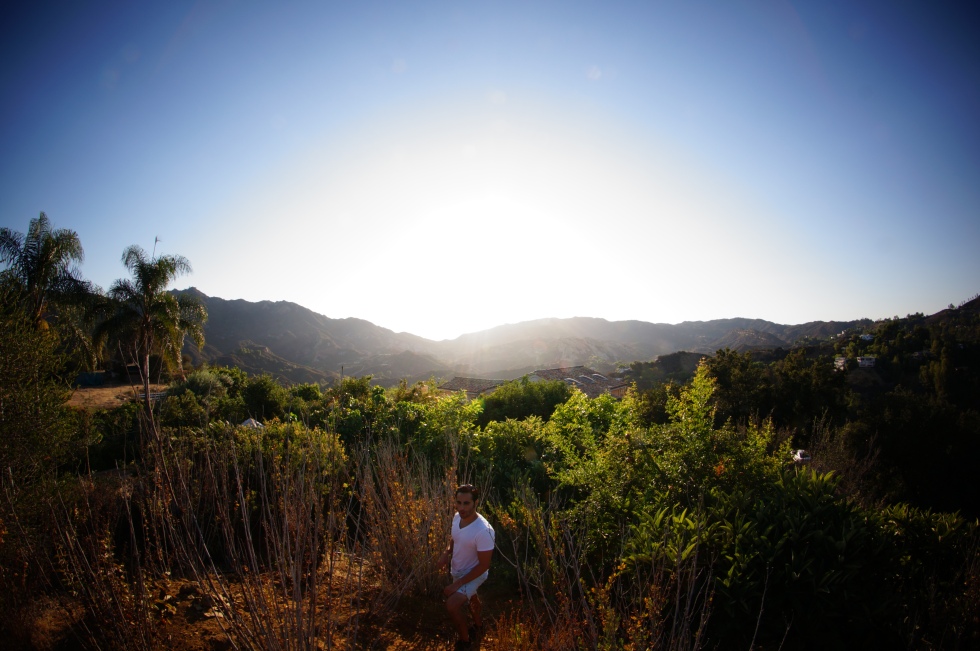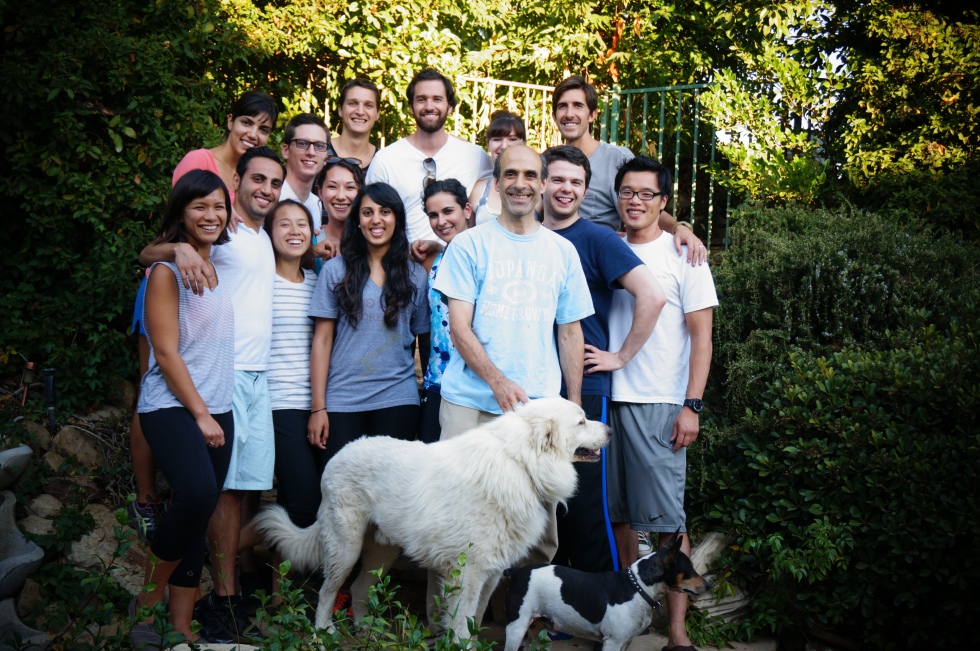Check out third year OMM/NMM Pre-Doctoral teaching fellow Izzy treating her family over the Thanksgiving holiday!
Author Archives: compfellows
Fellow’s Tea with the Dean!
This week the Pomona Fellows had the opportunity to sit down with Dean Paula Crone to catch up on COMP affairs, to inform her of the various projects underway in the OMM/NMM Department, and to receive feedback from her on what the Fellows can do to give back to COMP. While I have attended teas with the Dean up in the NW campus, it was the first tea that had been scheduled on the Pomona campus. Many of the other Fellows were unsure what would be discussed, but were simply excited at the possibility of chatting with Dean Crone on a more informal level. After the discussion, we all left feeling invigorated and inspired. We felt excited to use our unique perspective as both student and faculty to make a difference on a University scale, and to continue to grow this blog to reach out to our alumni. We are so grateful to Dean Crone for taking the time to chat with us, and look forward to making this a Fellowship tradition!
Keep your eyes peeled, we came up with some great ideas that we’ll be working on implementing soon….
-Ashley (A.mo)
Interview Day at COMP-NW
This past weekend was another interview day at COMP-NW. Katie and Molly had the privilege of speaking to the students about Osteopathic Principles and Practice as it pertains to the COMP-NW curriculum and beyond. Molly continued on to serve as part of the interview panel. Below are reflections from the day.
A Look Back Through the Eyes of Future Osteopaths by Katie Markelz, OMSIII
Fellowship allows an opportunity to reflect on where we are and how far we’ve come: as students, as teachers, and as leaders. One unique opportunity to view this progression is during Interview Day for prospective students.
This weekend, two of us Northwest fellows (Molly and Katie) were privileged to lead an information session and demonstration of osteopathic principles and practice, including osteopathic manipulative treatment to prospective students. Our first group was the premedical students who were considering applying or in the process of applying to medical schools. Our second group was prospective medical students selected to interview at COMP-NW.
Looking out into the sea of well-dressed future (hopefully!) osteopaths, we were reminded of our journey just a few years prior. We remembered the hours of coursework and application preparation, the constant pressure to shine and show off our full potential, and the anxiety that came with the unknowns of our futures. It was great to be on the other side of the fence this time! It allowed us to take a step back, and realize how far we’d come. In a few short years, we had learned an entire medical school curriculum and learned to care for and treat patients. A year or so more and we will be doctors.
This day we were challenged to compress three or four years of classroom and clinical learning into thirty minutes. We wanted to communicate the global picture, to help the students understand what being a Doctor of Osteopathy is all about. We started with the osteopathic philosophy, highlighted the curriculum, demonstrated structural exam findings and treatments and finally, retested the students to show resolution of findings after treatment. The audience was asked to assess eye levels, shoulder levels, iliac crest levels, gravitational line, and even scoliotic curves. They shouted out answers, and we discussed differing opinions. We talked them through what our findings could tell us about our patient’s structural needs. They learned how OMT can be used not only to treat musculoskeletal pain, but how it can benefit entire organ systems. Students were engaged and asking questions, getting excited about the prospect of having another tool to help them treat the whole patient. Here we were, a few years after having been in their shoes, sitting on stage with camera’s on us from multiple angles, teaching them as if we were longstanding faculty.
Perhaps the most impressive thing to reflect on was how easily we transitioned into this leadership role. Three short years ago, we had been looking up to fellows and faculty during our interviews. Now, we were the role models, the ones being looked to for answers. We were representing the school. The students would go home and reflect on their interview day as they sifted through which schools would suit them best. We were an integral part of this day, and would contribute to their overall impression of the program. It is our hope that we made an impact on them and got them excited about the next four years of their lives, about medicine, about health. Even if COMP-NW wasn’t the right program, at least the seed had been planted for holistic care and osteopathic manipulative medicine. We plan to continue to lead in our profession, and are privileged to have had pre-doctoral opportunities such as the fellowship to get our feet wet.
We wish the premedical students and prospective osteopathic students the best as they continue their long, grueling journey into the world of medicine. If there’s one thing we can offer, it’s that it’s worth it! Every step of the way!
…
A Look Ahead into the Future of Osteopathic Medicine, By Molly McCormick, OMS IV
Last weekend, I had the opportunity to represent the fellowship during a COMP-NW interview day. Reading through the application profiles of the 3 individuals my team was interviewing, I was reminded of a comment a physician had made during one of my own recent interviews for residency. He came into the room after the group of us had finished our interviews and could hardly contain himself as he stated how excited and encouraged he was because he had just interviewed the future of medicine and it was GOOD!
Reading through the profiles before me, my stomach started to sink as I realized just how accomplished these individuals were. From board scores and work experience to prestigious college affiliations and language fluency, I couldn’t help but compare myself to them and for the millionth time in the last four years, didn’t feel like I measured up. The culture of comparison is so engrained in us. But then excitement and hope gained their footing- this is the future of medicine! These are not nameless faces competing for medical school seats or residency slots, but rather my peers who are going to help me change medicine for the better. Their excellent grades and MCAT scores show they are capable of handling the information that medical school and residency will thrust upon them. Their diverse educational backgrounds; state schools, universities, ivy league institutions have equipped them with a variety of learning and teaching experience. Their incredible work experience as scribes, researchers, tutors, mentors, nannies, and fast food workers have endowed them with perspective and humility. Their fluency in world languages, cultural awareness, and life experience- from the loss of family members to the addition of new ones has helped bring compassion to a world that is starving for relationship and connection. This is the future of medicine… and it is GOOD!
As we continue down our own road towards residency, medicine, and beyond, my hope is that we stop wasting our time comparing our shoes to the shoes of our fellow sojourners. Rather, we will look around us and find strength in the men and women who are willing to walk this road. I hope we will then look out and find our horizon, we will know who we are and where we are going. My hope is that we will counter this culture of comparison with a culture of encouragement and hope in a medical future that, while – imperfect, busy, and exhausting, has the potential to be improved every day by men and women like the ones who interview at COMP-NW.
Unifying COMP: Piloting the Fellowship Intercampus Exchange!
The Fall 2014 semester marks the implementation of the inaugural NMM/OMM Fellow Intercampus Exchange program. The intercampus exchange is a voluntary program designed to allow OMM pre-doctoral teaching fellows to experience the fellowship from both campuses, Pomona, CA and Lebanon, OR. This is intended to strengthen relationships between campuses and allow for more open communication and interaction in order to improve the overall experience we provide for the COMP students.
Two fellows participated in the exchange this semester, which lasted for three weeks. Justin Brohard PDTF-4 COMP travelled up to the Lebanon campus while his counterpart, Kraig Wasik PDTF-4 COMP-NW, came down to teach in Pomona. The experience was very enriching for both individuals and helped each department explore their practices and search for improvements in communication and the delivery of the OMM curriculum. Most of all, the fellows were able to build much stronger relationships with each other, between campuses, than they otherwise would have. Here is some of the feedback from the participants:
“After completion of the intercampus exchange program, I can proudly say that while there certainly differences between the two campuses, they are not as drastic as I had previously thought/anticipated…I feel very strongly that this program improves the relationships and streamlines professional communication between the campuses. I have assumed the role of intercampus ambassador at this point and feel that my experience with both campuses, and my understanding of the intricacies of inter-personal relationships and work place organization makes it easy for me to convey the differing perspectives between fellows on each campus.”
~ Justin Brohard
“I think the biggest benefit to the exchange was the increase in communication and the personal relationships…It was great getting to know both the faculty and fellows in Pomona and doing the exchange will only further strengthen out departments and the OPP curriculum…I think three weeks gave me a fair idea of how the fellowship in California works. I was also able to act as an “ambassador” of the NW campus to the students of Pomona and answer their questions about Lebanon…I think the student exchange is a great thing.
~Kraig Wasik
This is a program that we are planning to continue in the coming semesters and hopefully make this a tradition and a very enriching program for each fellow to have the opportunity to experience during their tenure with the department.
Thanks for all your continued support!
Justin Brohard
Memory Tools: Rib Dancing!
Sometimes the best way to communicate material to our students is through fun and creative memory tools. It just so happens that the treatment positions for rib muscle energy for exhalation somatic dysfunction shared some similarities with a popular K-pop dance craze we all love. The fellows decided to bust a move and show off their rib muscle energy skills, Gangnam Style! Here are a few still shots from the awesome video by Adam… but you can check out the full production here : http://youtu.be/sTZX1QrsClw
Journal Club 2014
Research Articles:
Quantifiable effects of osteopathic manipulative techniques on patients with chronic asthma
Osteopathic Manipulative Treatment for Pediatric Conditions: A Systematic Review
Introducing an osteopathic approach into neonatology ward: the NE-O model
Potential New Dimensions in Dermatology: The Osteopathic Approach to Cutaneous Disease
Resources:
Varieties of Bias to Guard Against
Improving Journal Club Presentations, or, I can present that paper in under 10 minutes
Tahoe Co-Campus Retreat!
This past weekend, the Fellows from both the Pomona and Lebanon campuses continued the tradition of meeting in Lake Tahoe for a co-campus retreat for some introductions and team bonding.
Tahoe Fellowship Retreat Fall 2014 – By Lee Kenyon, OMS III
So what was the goal of the 2nd bi-annual COMP Fellows Retreat? Was it to improve inter-campus collaboration? Was it to participate in team building exercises? Was it to have fun? Regardless of what my ideas were before the trip, I can confidently say that it a huge success.
The adventure started early Friday morning, 2 weeks into the Fall Fellowship. Although we departed approximately 12 minutes and 32 seconds after the goal departure time (Fig 1), my Type A Personality was able to maintain composure. It should also be noted that due to time constraints, we had to skip step 3…
Fig 1. Tahoe Itinerary
After arriving in Tahoe without any major hiccups, we grabbed some Thai food and headed to the rental house. The Pomona Fellows had already arrived and were busy exploring the beautiful property (it even had a billiard table!). After everyone claimed their rooms, we prepared for the first fun event of the retreat – a Murder Mystery! What better way to get to know our cross-campus counterparts than to see how well they can handle dress up?
Ashley had assigned roles and everyone seemed to take on their characters’ personas surprisingly well. (Ask Justin and Kraig about their roles as British sisters)! Costumes were improvised, laughs abounded, and by the end of the night we were all getting along like old friends (even us 3rd years who were more unfamiliar with the rest of the group).
Day 2 had an early start. A handful of the group got an early morning workout in and 3rd years cooked up some delicious crepes, bacon, eggs, and parfaits. The rest of the afternoon was spent at the beautiful Tahoe beach. We managed to find some unoccupied sand and spread out. After a quick dip in the water we laughed through a variety of team-building exercise. What started off as a race between two teams ended with a unifying task that helped us realize working together towards a common goal is a lot more efficient than trying to compete against another group with a similar mission. This echoed strongly with our job as fellows. Even though we are in two locations, the natures of our tasks don’t have to be competitive. We are all working towards the same goal as OMM Fellows – and we can undoubtedly do a better job if we all communicate and build on each other. We finished off the exercises with a superb human pyramid that managed to attract some local fans! The rest of the afternoon was filled with volleyball, napping, gymnastics, swimming, more napping, and a special birthday serenade to our very own Izzy Pines.
On Sunday, Izzy and her mother were kind enough to gift us all with a trip on some very scenic gondolas that took us to the top of Heavenly Ski Resort. We were able to hike around and take in the gorgeous view of Lake Tahoe. The evening ended with a friendly cooking competition where each team was limited to 5 ingredients. Luckily for me, the rest of my team made up for my lack of prowess in the kitchen. See below for the competing dishes:
Monday morning came too quickly and we were forced to pack up and depart back to our respective campuses. However, we left with much more than we came with. Before the trip, we were only faces and voices over a computer monitor. Now, however, we are friends with inside jokes, we are fellow adventurers, we are teammates. I’m confident that following the retreat I am much closer with my counterparts in Pomona than I ever would have been before. I’m excited for all the future holds for us – let the countdown to Convocation begin!
Fall Fellowship Underway!
Dr. Redding Workshop
We kicked off the semester with the wise knowledge of our very own Dr. Redding! He showed us various techniques that he uses often during his practice. I happened to be sick with a minor upper respiratory infection and sore throat the morning of the workshop. Dr. Redding decided to use me as a model to share his wisdom and techniques for addressing upper respiratory complaints along with other complaints commonly encountered in clinic. It was very interesting to see how he applied the Osteopathic principles into addressing my complaint. Within 5 minutes, Dr. Redding got all the fellows involved and I had 3 fellows treating me at the same time. It was an excellent workshop to see real world applications of some of the techniques we learn in class.
After getting treated with lymphatic techniques and counterstrain, I felt a clearing of my airways and decrease of pain in my throat. I was amazed of how quick my body can react to osteopathic manipulation and improve my symptoms. Dr. Redding also showed us some cool techniques that are not taught in the curriculum. One of which was a technique for addressing ear infections involving the Eustachian tube, referred to as Finger surgery. With this technique you place your finger inside the patient’s mouth contacting the torus tubarius, which is the base of the cartilaginous portion of the Eustachian tube. It was uncomfortable for some of the fellows and had a strange sensation, because it activated gag reflexes, especially for those who were sensitive.
We ended the workshop with the world famous “Dr. Redding’s Lymphatic Dance.” On behalf of the fellows and myself, I would like to thank Dr. Redding for dedicating his time and sharing his expertise with us. Thank you Dr. Redding!
Cranial Week
Gearing up for this year’s cranial week required some serious cobweb removal. My last time participating in the course was when I was a second year student. I’ve used the principles and techniques from time to time when treating people and stayed up to date on the mechanics for boards purposes, but it had been 3 years since I’d last delved deeply into the anatomy, theory, and underlying concepts of osteopathy in the cranial field (OCF). After a couple weeks of excellent workshops with Dr. Giusti, we (the fellows) felt primed to help guide the second years into a unique and interesting component of osteopathic medicine.
Our main role as fellows was to facilitate the small group sessions with students. These hours are rewarding for everyone involved, as they are fun, intensive, and unique sessions. We really enjoy the focused time with the students, and find creative ways to reinforce concepts and review principles. One such activity is the “building a face” portion of the cranial bones motion review. Using disarticulated skulls, each student will hold onto one bone and demonstrate its motion relative to the bones around it. As each student sequentially adds their bone to our developing conglomeration, a fully articulated and moving skull takes form in the middle of the breakout room. We all call out the different phases of motion and can appreciate how the bones interact with each other under normal physiologic motion. It’s a pretty good time all around.
On an individual note, I gained a much deeper and thorough appreciation for OCF during my second runthrough. We get to attend all the lectures, and without an exam looming in the future, I certainly feel more able to learn for the sake of learning and make connections between concepts that easily blew over my head just a few years ago. “Aha!” moments abounded for me as the week progressed. I did my best to take these lessons to my small group and found it a bit difficult to stifle my enthusiasm at just how cool it was when things gel and make sense. It’s a bit like studying calculus. One day, those squiggly lines with letters at either end become functions, derivations seem logical, and your perspective changes; you see things the way your educators do, and the fog rolls away. You don’t even necessarily know what you did to make it happen, like the first time you let your gaze drift and one of those 3D art pictures pops out at your face. Needless to say, moments like these affirm that I have a long way to go on my quest for understanding, and that it will be a fun and eventful ride along the way.
That being said, to any second years reading this and having difficulty with OCF – keep at it. Stay the course and keep palpating.
Thanks for reading and always be learning!
Casey
Rap around the point
-
Here on fellowship we utilize a variety of different modalities to engage our students in learning OMT. We theme our lectures, incorporate dances to remember techniques, and we even throw in fun mnemonics as a memory tool. The Fall 2013 fellows set the bar pretty high last semester – they dressed up as Jasmine and Aladdin and rode in on a “magic” OMM table, they had a Super Troopers themed lecture, and they even developed review games for the ends of their lectures. My first lecture was to be on anterior thoracic counterstrain which, unfortunately, fell on the fourth hour of the day and followed an IDIT exam that morning. I knew that the students were going to be exhausted by the time my lecture rolled around so I needed a way to motivate them to learn! A month earlier, on my endocrine rotation, I had been given a lecture that incorporated music to assist in learning a concept. I remembered how fun it was but also how effective it could be. This would be a perfect way to end the day! I decided on a theme of Fresh Prince of Bel Air and as I wrapped up my lecture, I sang/rapped the opening song of the show with a little osteopathic twist. Here it is, enjoy!
Fresh Prince of OMT lyrics
Now, this is a story of OMT
Anterior thoracic counterstrain
And I’d like to take a minute
Just sit right there
I’ll tell you how to become a master of all twelve points
We start out with AT 1 and 2
Suprasternal notch and manubrium
Chillin’ out slouchin’ relaxin’ all cool
And just holding the point til you heal them full
Then you work your way down to 3 and 4
You’re cuffin their hands and they’re crunchin their core
Now all the treatments are the same for 5 through 8
I said ‘You’re flexin’ the patient forward til they have no pain
I’m telling you we only have four more to go
The next three the patient can get comfy fo sho
Just give them a pillow, flex to 135
And I check ‘Yeah, you got it’ – ‘Yo, homes you’ll survive’
AT 12 is bilateral and last on the list
Love em but wait I said “with a twist”
I look at you students
And you’re finally there
Mastered the points, now show the patients you care
-Natalie Hollick, PDTF III
Pediatric Workshop with Dr. Magoun
February 26, 2014
We had the wonderful opportunity to learn more about OMT applied to the pediatric population! Dr. Magoun graciously took time out of her schedule to teach us her techniques and approach to the newborns and children, and what better to practice on actual LIVE children!! And LIVE children we had as our own fellow Justin Hall donated his three children to the cause! We had a great experience with Dr. Magoun and the fellows, having a mixture of learning and play time with the kids.
The most challenge part of treating the kids was timing. Depending on position, their level of distraction, if they fed, if they used the bathroom yet, and if they even napped prior really directed Dr. Magoun’s focus and treatment. At times she would be treating the thoracics but suddenly she would have to move to the pelvis then back to the thoracics.
Personally, because I am going into pediatrics, this was a great opportunity to see how to apply OMT in my future clinical world. It contrasts my learned approach of knowing the patient will be cooperative and stationary. I can never assume the patient will be coorperative and will ever be able to give me feedback. Regardless, I learned that sometimes you don’t need the patient to TELL you they feel better or they appreciate what we are doing for them… it’s reading their body language. It was a great experience and I look forward to developing my pediatric OMT skills.
Visit of French Osteopath, Thu-Van Attali
On 2/25/14, COMP fellows and WesternU welcomed the visit of French Osteopath, Mrs. Thu-Van Attali!
Mrs. Thu-Van Attali had written an article, Treatment of refractory irritable bowel syndrome with visceral osteopathy: Short-term and long-term results of a randomized trial published in the Journal of Digestive Disease. Dr. Halbeisen, DO an OMM/NMM +1 visiting physician at the department contacted her to inquire the techniques components of her paper. Mrs. Attali happened to be in Southern California and visited us with her husband. Mrs. Attali demonstrated and provided a workshop to the fellows on the visceral techniques that she used in her research and also shared some of her clinical pearls. The fellows definitely enjoyed the workshop and had an awesome time with her! Thank you, Mrs. Attali for sharing your knowledge and skills with our fellows!
-Albert Lee, PDTF IV
OPSO Seminar With Dr. Stiles: Cranial Key Lesions
This past weekend the NW fellows took the opportunity to attend the OPSO conference in Sunriver, Oregon. We had been looking forward to this conference for weeks not only for the great location, but for the bonus OMT seminar on cranial manipulation on the first day… only 7 days after EOC week for our 2nd year students. This seminar was lead by the distinguished Dr. Edward Stiles! Several of the 4th year fellows, myself included, attend his “Finding the Key Lesion” lecture every year at convocation. He is a dynamic, engaging speaker… and I usually have some sort of earth-shattering revelation during his lectures. This one was no different! I don’t know that I will be able to fully convey how profound his lecture was, but I’ll certainly try.
Dr. Stiles, who studied with Laughlin, began by discussing cranial manipulation as a “great product with bad marketing.” In his eyes, one primary focus of cranial osteopathy that had come from the great practitioners of the profession had been underplayed by much of osteopathic education and teaching: the sutures. He explained that all of the strain patterns taught in classical cranial courses often were a result of multiple sutural restrictions, with one primary sutural restriction. If we could treat and release the restrictions of that particular suture, we could unlock multiple restrictions in the cranium. I looked over to some of our 2nd year students who were in attendance. Their gaze fixed on Dr. Stiles, I could see the wheels turning behind their eyes. This was a completely different way of thinking about the exact same information they had received in the EOC course a week prior.
Dr. Stiles stated that there was “sutural sequencing” that was unique to each patient. If we as osteopathic practitioners could perform our cranial assessments and determine which sutures were restricted, and ultimately find the most restricted suture, we could treat our patients “faster, deeper, and more effectively.”
That’s when it hit me. This was a key lesion lecture… but tailored to cranial.
Take a torsion strain pattern, for example. If we treat the sphenozygomatic suture (between the greater wing of the sphenoid and the zygoma) first, the strain pattern will often completely relieve itself. While balanced membranous tension and other cranial techniques would work, treating this ‘key suture’ is much faster and more effective. It enables osteopathic practitioners, who otherwise might not use OMT due to time constraints, to use their hands more regularly.
Dr. Stiles then described his principles for evaluating and treating the cranium. He conducts an overall screening examination of the cranium with the goal of finding the most dysfunctional suture. Is it a specific suture? Is it the SBS or sacrum? Then he introduced the concept of a “Dynamic Balance Point.” He described this as loose packing each bone on either side of the suture you are treating and stacking planes of ease… a bit like myofascial release. You can essentially motion/glide test the more restricted side in anterior/posterior, medial/lateral, and clockwise/counterclockwise directions. You then do the same for the other side of the suture you are treating, stacking the direction of ease.
You subsequently add compression of that suture. “Sometimes sutures want to compress more before they spring open and release,” said Stiles. However, this is not some arbitrary amount of compression. He described this as adding enough pressure that your hands are “blending into the bone.” He described this as the point where you feel like you are no longer holding the cranium in your hands. Only then, with the right amount of compression, would the release occur. What?! There is no way that it is possible to feel like you’re holding nothing but air, I thought. As I practiced on Molly, one of the other Fellows, I was surprised to notice that I could feel that motion as I glided her right occipitomastoid suture into an anterior direction. I felt like my hands were making these huge arcs, when in reality they were hardly moving at all. Once I found the dynamic balance point, I added compression. I was adding a lot more pressure than I hand anticipated, but moved slowly so as not to overshoot my goal. I can still feel her head in my hands, I thought. Just as soon as those words went through my mind I found it.
It felt like my hands were floating… like my hands had melted into her skull. The weight of her cranium in my hands had seemingly evaporated.
I was in disbelief! I could practically feel the neurons exploding in my head moments later as I palpated a great expansion under my hands, followed by a sensation of warmth. With my eyes closed, it honestly felt as though my hands were a foot apart from one another, and widening still. I opened my eyes and almost felt surprised to see that they were still on Molly’s occiput. Her eyes were as wide as mine, as she too felt that expansion as the OM suture released.
Mindblowing. There aren’t words that can truly describe that experience.
According to Dr. Stiles, the end result of a treatment isn’t necessarily symmetrical. As long as all sutural restrictions are released, the patient is asymptomatic, and there is good inherent motion, you have done your job. Our goal as practitioners was to “Find the key dysfunction, enable the health and restore the patient’s unique pattern of motion to bring them back into better function.” He gave us additional pointers for finding dysfunctional regions, such as looking for the ‘hard spots’ along suture lines, looking at the pivot points of the cranial bones where bevel changes occur, etc. One question from our first breakout experience remained: how was it that the right amount of therapeutic pressure in one finite location could initiate such a profound change?
Tensegrity.
Stiles described the cranium and the body as one giant tensegrity model. This concept has always been fascinating to me, and my fellow fellows and I were surprised that this model had not been discussed previously… at least not in this way. Tensegrity fully explained what we feel as osteopathic practitioners. To review, tensegrity allows for an even force distribution in a system that is non-linear. He described the cranium as a curved tensegrity model- a system that wants to continually expand, but is held together by tension. The bones of the skull would continually expand if it were not for the tension put into the system by the dural structures: the tentorium and the falx. Thus, the dura enables the cranial sutures to remain open AND functional! He used the example of a growing brain—how is it that the bones of the skull do not continually expand as the brain grows? The dura maintain tension on the system. He postulated that rather than brain growth dictating the size of the skull, it is the cranial tensegrity system that allows for growth of the brain to a specific size (and subsequent maintenance of that size overall).
Because of this tensegrity system, minimal dysfunction produces maximal facilitation. That is to say, that one sutural problem can alter the cranial tensegrity system greatly–which manifests as multiple compensations, restrictions, and dysfunctions in the head and body.
I could go on discussing this topic and the information Dr. Stiles relayed to us in this seminar for days. I’d have a novel written by the end! He said so many important things, and provided such a different perspective on cranial osteopathy. This piece is only touching the surface, the first layer of information. I am so grateful to have been able to absorb as much as I did in such a short span of time. I cannot wait to explore the ideas he spoke about, and hopefully glean more from additional workshops in the future. With that, I will close with a quote from Dr. Stiles that I thought was so appropriate, so inspiring, and so applicable to the concepts he discussed throughout this workshop:
“What you learn in medical school is the melody of a tune. What you see in practice is a jazz variation. We should honor our patient’s uniqueness and complexity, and find the hindrance in their system to unlock their greatest health potential.”
-Ashley (A.Mo)
Spring Fellows Retreat
Lebanon’s experience:
Tahoe Fellowship Retreat 2014- Kraig and Katie
A few weeks into the Spring semester, the 5th year leaders of each campus coordinated a joint fellows retreat in Lake Tahoe. It’s becoming a tradition of sorts, since the fall fellows arranged a similar retreat. The goal of the long weekend was to unify the two campuses of fellows, making communication and collaboration more effective for teaching.
One week before the trip:
Starting to question this crazy idea. Only 4 of us are going now, two of us feeling a bit under the weather, and a sick baby. Oh, not to mention the endless drive ahead – up to 12 hours with stops! For only a 4 day weekend with a bunch of people we could just meet over google hangouts. This was starting to feel like a lot of work for nothing.
Morning of the trip:
The Fearless Foursome, Kraig, Katie, Amy, and Ashley, (+ baby Savannah) depart Lebanon, OR. We meet at “the Ridge” (Ashley’s apartment), pile into Amy’s CRV, and hit the road. I’m happy to ride in the back seat and catch some shuteye. The morning passes with some small talk, baby crying/feeding/changing, resting, and classic rock over XM radio. After breaking for lunch, we continue our journey with increasing excitement, as the prospect of meeting our fellow Pomona Fellows grows near. Maybe this won’t be so bad, I began to think.
We make our way through middle-of-nowhere Modoc National Forest, California. But despite the boring scenery, we begin to pass time with car games – what became really fun car games. I (Katie) shared a game I previously used to pass time when cycling across the country: “Contact.” It is a simple word game, sure; but one that passed 3-4 hours of our drive. Before we knew it, we had arrived in Incline Village, NV, a town settled on the banks of Lake Tahoe. We parked, and hesitantly made our way in to meet our mysterious counterparts.
Upon entering the vacation rental, we instantly felt at home. The house was warm, not only with heat but with excitement. All 4.5 of us were greeted with hugs all around from the 7 others. We soon learned that the group had already gone shopping for the weekend and were about to head out to pick up pizza for dinner. We were offered drinks, and all gathered around the living room. Conversation flowed throughout the room. Everyone was happy, smiling, eager to learn about one another. So much so, that it took effort for our fifth year trip organizer, Casey, to motivate everyone to get ready for our first ice breaker event: The Murder Mystery Dinner.
We had each been assigned characters over email. Tonight, we were to get into character, and interact with the others to ultimately determine who killed Ramon. We were casted as Bernetra, Ramon’s distant mother. She was a posh, snooty old lady. Together, we greeted the others: hippies, the club dancers, the nightclub employees, and the drug dealers. While none of us were anywhere close to our casted roles, nor were we proficient actors, we all did our best to stay in character and stay true to the story. I was anxious about it at first. But after a few minutes, it felt so easy, so natural. Perhaps because we had a common bond, the fellowship and our love of OMT, that we instantly felt comfortable together.
The rest of the night we played all sorts of games – somewhat of a collaborative game sharing between fellows. We played mafia, catchphrase, salad bowl, and of course contact.
The next morning came rather quickly. Sleeping on a fold out couch in the loft space, all of the noise of the morning carried up and echoed in the little space. People were reliving “Wayne’s murder confession” from the murder mystery game the night before. I (Kraig) joined ship with some of the Pomonites and took a nice walk to Starbucks. When we returned back to the house, the rest of the third years were chopping veggies and getting everything prepared to start making breakfast. The rest of us joined in and made omelets (made-to-order with all the fixings), bacon, fresh fruit, and toast for the rest of the group (Much thanks to Dickran and Gavin for doing all the cooking!!).
After we all recovered from a large breakfast and ingested some much needed coffee, Casey and Amy (our fearless fifth year leaders), explained out next ice breaker game. We were split into two groups with an equal amount of lego pieces and an obscure model to build as a team. Each person on our team would run into the room with this complicated model in it and was given 15 seconds to memorize as many pieces as they could. The hard part then came when this person had to explain to their team how the pieces were put together. This was especially challenging for us OCD and cone challenged participants….
The first few minutes were filled with lots of frustration and confused team members. I would memorize legos and come back to explain them, only to completely forget what I was looking at. Luckily my team was supportive and encouraging. Both teams seemed to have developed the same strategy, focus on 2-4 blocks at a time and build slowly. Both teams “finished” at the same time, but “The Donkey Dominators” prevailed over “Bob the Builder” as they had one block out of place. All and all the game was a success. We learned to work as a team, tailoring our strategies as we learned what worked and what didn’t. Plus, we all formed a special bond in our loathing of Casey and his complicated model…
In all seriousness, it was a clever game really, emphasizing the importance of communication: something that was crucial for fellows of both campuses in order to teach a unified and parallel curriculum. Plus, we were continuing to become friends. These people wouldn’t be strangers. Instead, they would become a new family, people we looked forward to collaborating with on lectures.
The rest of the weekend went on without a hitch. We cooked together, hiked together, went to North Star village and ski resort to go ice skating, and saw the Seahawks win against the 49ers for their chance at the superbowl. Perhaps most impressive was how much we each laughed until we cried, and screamed until we lost our voices. We had only known each other a couple of days…. but there was no doubt about it: we were creating memories that would last a lifetime.
The week after Tahoe: COMP NW, Lebanon, OR
Kraig google chats Dickran. I (Katie) am so excited to say hi, that I stop working and go over to chat with him too. Judy comes in the picture on the other side, and then I start my own chat with Judy and Gavin. Later that day, when troubleshooting LINK, I see Casey on screen. I want to talk to him, but our microphones aren’t synced up. Regardless, I am excited to see him. The next day after my live lecture I am eager to introduce myself to Brendon to coordinate the rest of the lecture hour. I suddenly have this extended family, one which cares for me and supports me. I appreciate my interactions with them, and I look forward to joint meetings and streaming, even if technology gets the better of us from time to time.
Work has never been so much fun.
We love you Pomona Fellows!
Katie and Kraig
P.S. See you all at Convo! Can’t wait!
TOTES MAGOTES
Pomona Experience:
Pomona 3rd year Fellows: A chance to bond with the fellows in Pomona and Lebanon at Lake Tahoe during MLK weekend was even more exciting than we expected. There had been practically no new snow for months and the prospect of enjoying outdoor snow was low, however, our 4 day 3 night trip, was enough time to truly get to know each other indoor and outdoor in beautiful weather.
Casey drove his “brick” car with Natalie, Albert and Lynn. Dickran and Gavin took turns driving a rented Dodge with Judy as the DJ in the backseat. We took the scenic route on the 305 passing by the breath taking views which was definitely good for our souls! First stop was at Bishop, CA for some yummy burgers at Burger Barn. We arrived at our cozy cabin after 8 hours of driving then went to Raley’s (equivalent of Ralph’s in Socal) for some grocery shopping while waiting for the Oregon counterparts to arrive.
First night involved solving a murder mystery at an English nightclub, Buzby’s. Our alter egos definitely came out that night, especially Wayne. Here were the characters:
Casey (hans solo, hehe) –> Herbert
Lynn + Natalie –> Toloula
Albert + Judy –> Wayne
Dickran + Amy–> Mississippi
Gavin + Ashley –>Fee Fee
Kraig + Katie –> Renetra
Rest of the retreat involved playing an assortment of team building games, one after another: contact, salad bowl, telegram and our favorite iphone game, “Head’s up”.
Physical activities included: hiking to Diamond Peak, ice skating, snowboarding and cheering for the Seahawks vs niner’s game (won’t say which team) at North Star Village. We also showed some OMM love by treating each other throughout the retreat.
Overall, we developed a great friendship among the Pomona Fellows and with the Lebanon Fellows. (By the way, BIG BIG BIG thank you to the head person planning this whole trip: Casey Pyles, our beloved 5th year Pomona Fellow- You deserved the master bedroom and all! We love you!). Also Amy Martin, 5th year Lebanon Fellow brought a special guest to the trip, her 4 and a half month old daughter, Savy. Savy brought such joy to our company. Thank you everyone for all the good memories. We are so excited to work with an amazing team this semester!!
Meet Savy!
Meet Wayne, Herbert and Wayne
Sous chef= Gavin and Dickran, Executive chef= Judy
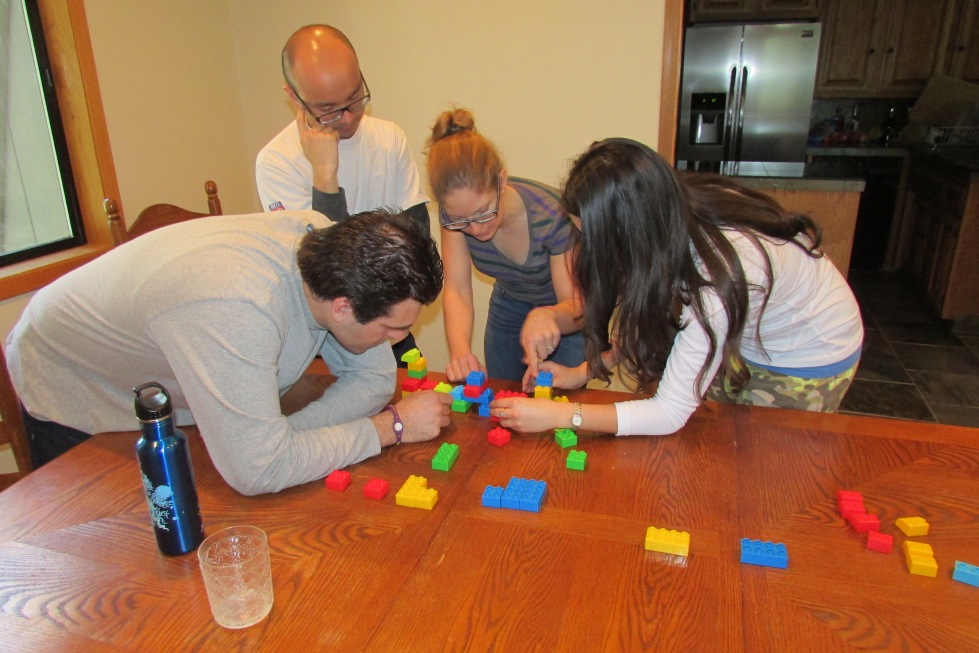

Someone is not happy about this game
Trying to remember the pattern
The boys giving Savy all the attention 🙂
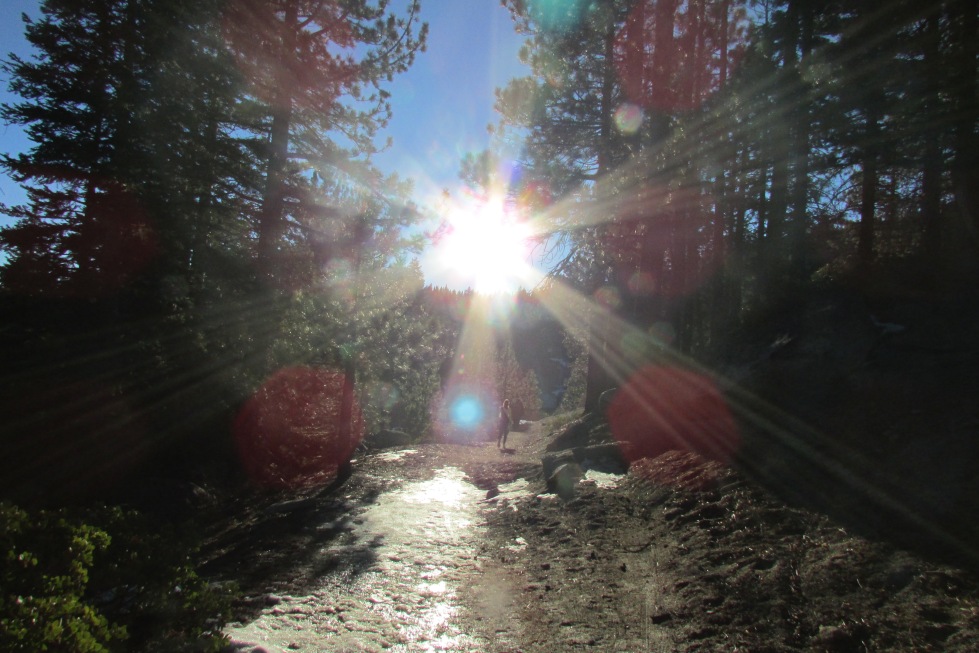
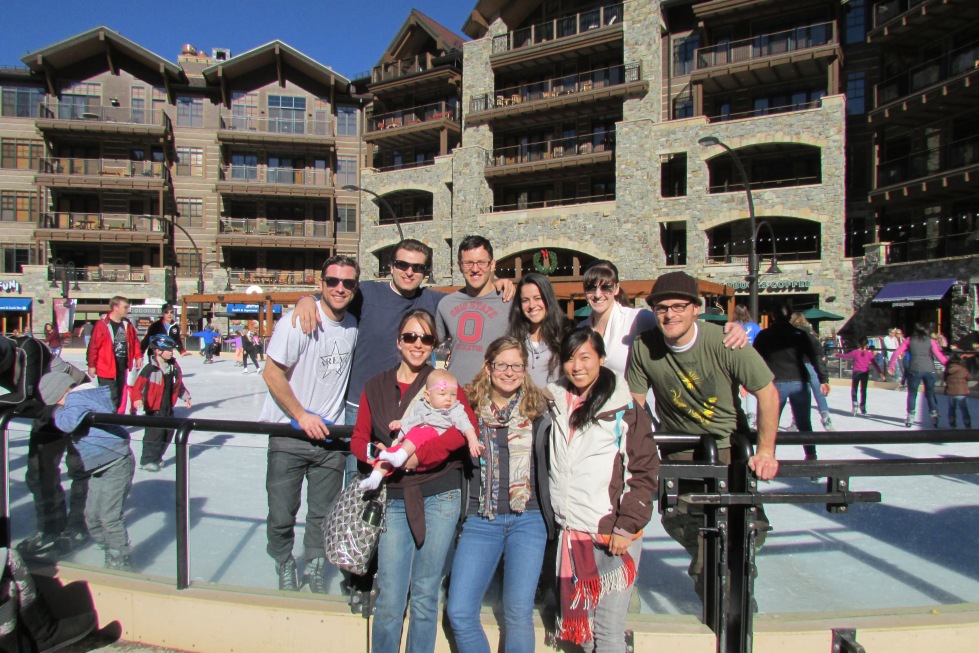
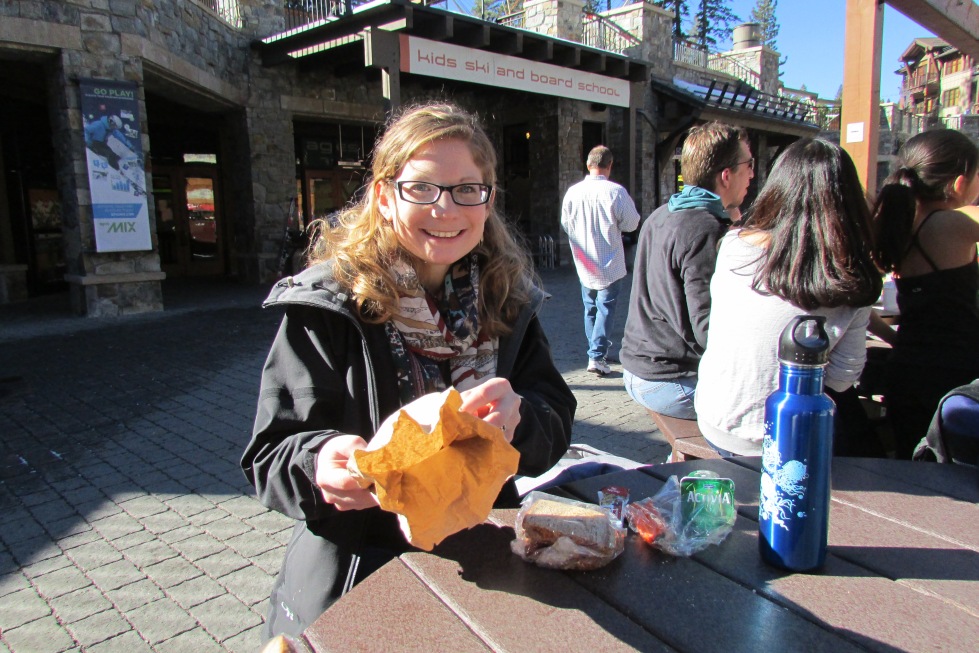



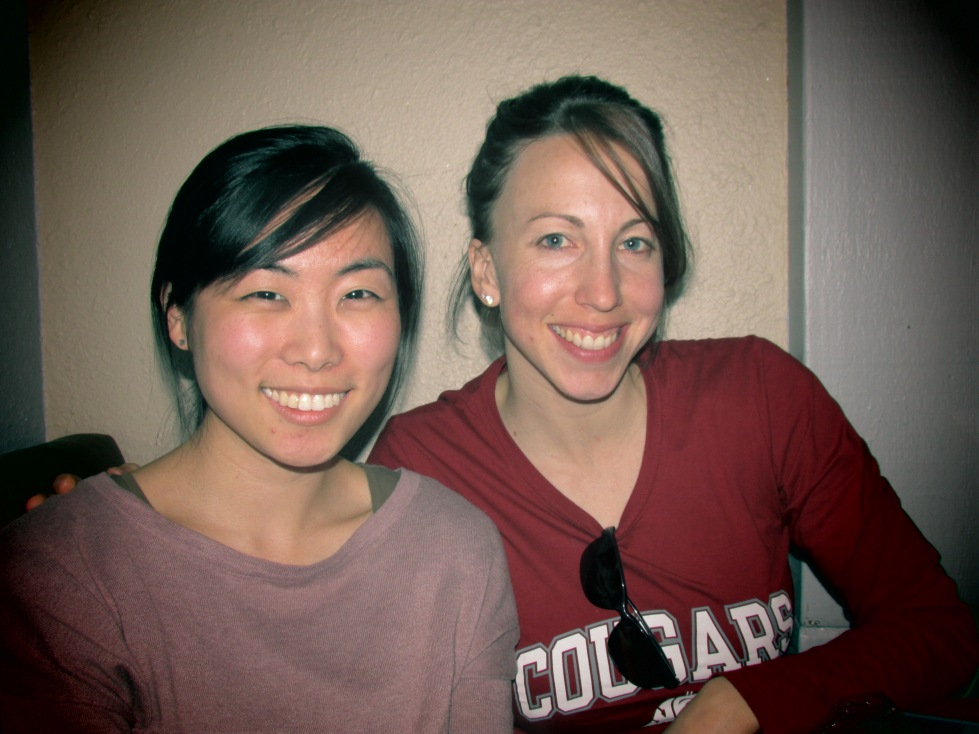
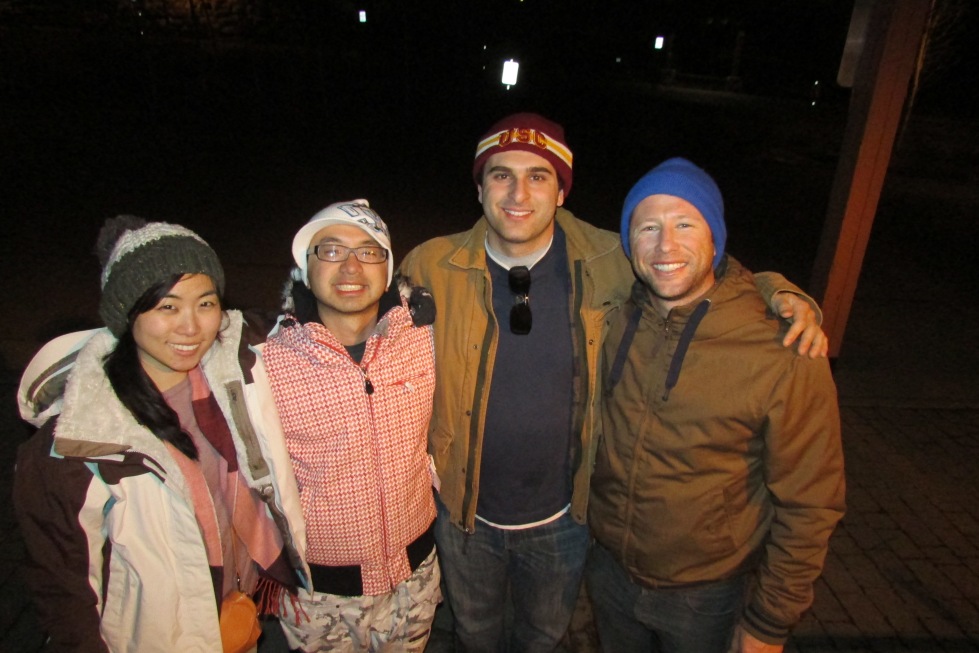
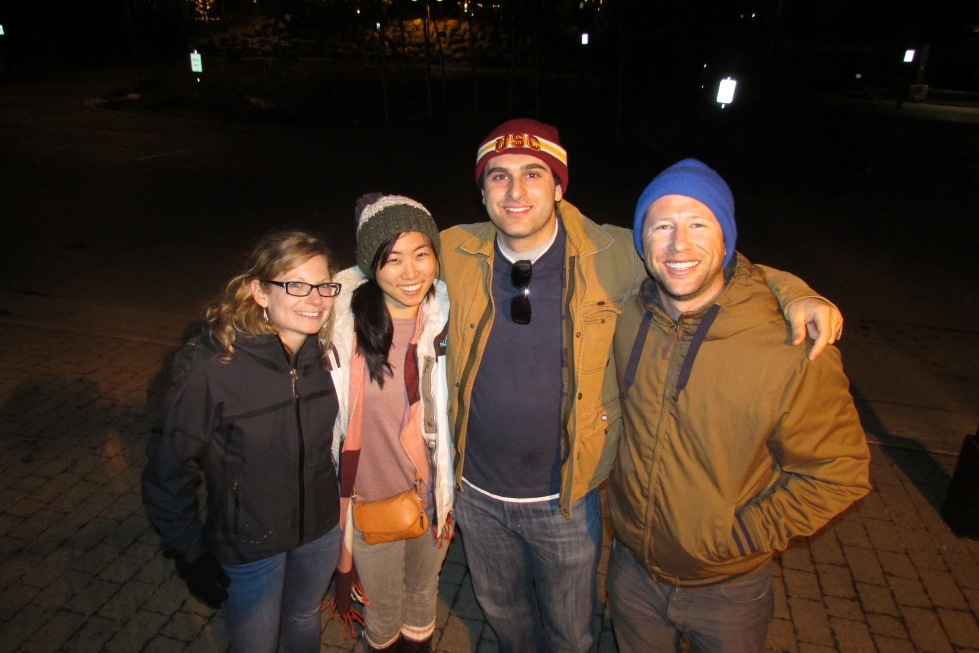
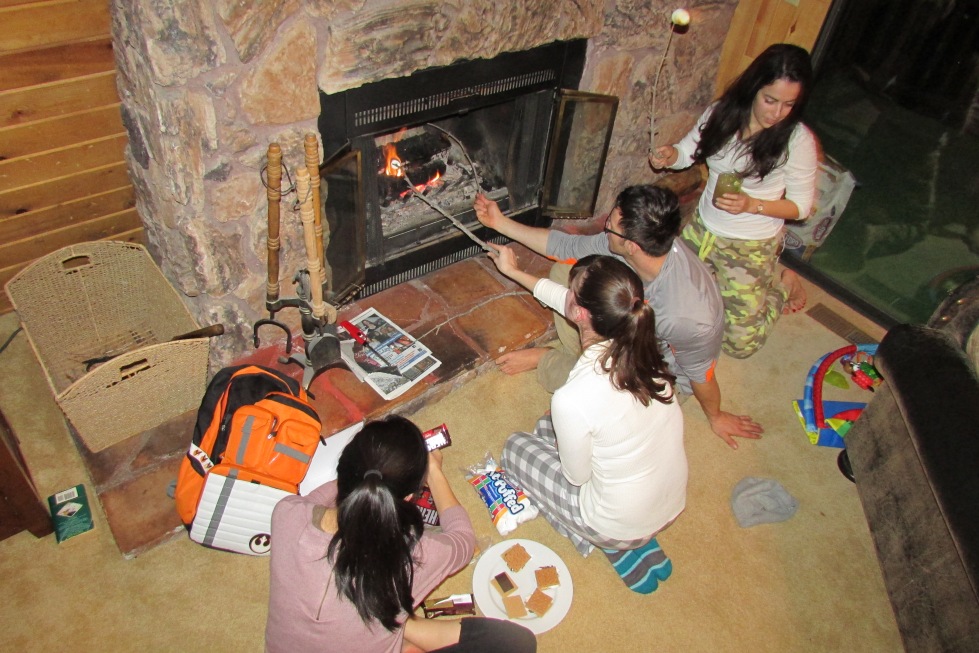
Looking forward to our bright future!
Dr. Hagopian Workshop
Each semester the fellows trek out to beautiful Topanga Canyon to do a workshop with Dr. Stefan Hagopian. This year Dr. Hagopian gave a thought provoking lecture using a 3D anatomy slideshow, led us through a pediatric treatment session for cranial interosseus strains with a guest patient, and then guided us through a palpation workshop revisiting classical techniques utilizing 3D anatomy. Here are a few photos of our lovely afternoon. As always we left with full bellies and enriched minds.
Here is an article highlighting Dr. Hagopian’s osteopathic philosophy: Stefan Hagopian DO, On Becoming an Osteopath
Journal Club Fall 2012
Attachments for all of the journals we read this semester:
Yoga for Chronic LBP. Tillbrook. 2011
Spinal Manipulative Therapy for Low-Back Pain (Review).Cochrane.2012
SMT for Chronic LBP. Cochrane. 2011
Osteopathy improves the severity of IBS.Florance.2012
OMT in the ED for Patients with Acute Ankle Injuries. Eisenhart.2003
Applying Osteopathic Principles to Formulate Treatment for Patients With Chronic Pain.Kuchera.2007
Empathy in Osteopathic Med Students A Cross Sectional Analysis. Kimmelman.2012
The Fellows have a HANDS-ON Thanksgiving!
A touching thanksgiving
Per usual the holidays have snuck up on us again. I swear it was still 90 degrees down in Pomona a week ago, and suddenly November is coming to a close. Last weekend, several of us got to spend a little extra time with loved ones and had the opportunity to treat the people (and animals!) in our lives that we are truly thankful for. We traveled from Pomona and Lebanon to all over the country, some of us had OMT tables, some of us improvised. Here is a tiny glimpse into how we showed our thanks using osteopathic touch.

Shannon Bell, PDTF 2015 applies some recently mastered skills she acquired from Dr. Tikker’s (an osteopathic podiatrist) workshop last week. That foot sure looks thankful!

Ashley Mohadjer, PDTF 2015 and former ballet dancer: “Over the Thanksgiving holiday I returned to the my ballet company’s studio to take a class. My hands are pictured here, as I treat a dancer’s ankle injury using myofascial release and articulatory techniques before her Nutcracker rehearsals!”

- Chas Leyster, PDTF 2013: “Even though he was battling gastroenteritis throughout this holiday weekend, Gray Gray’s cranial rhythm was moving beautifully…I wonder if this correlates to the happy and cheerful mood and attitude he has maintained while expelling this virus from his body. I am honored to be his father!”

Abigail Schenkel, PDTF 2015, shows her thanks for her pup Oz by performing Spencer technique over the holiday break.

Sarah Fang, PDTF 2014, “I had a steady stream of post-prandial turkey coma patients rolling themselves from the dining table to the OMT table from the moment plates were cleared all the way through pie time!”

Brendon Ross, PDTF 2014: “This Thanksgiving Break, I had the opportunity to treat my Dad for the first time. Family is always tough to treat because you don’t want to look like a fool in front of them, especially your Dad. For an hour, we attempted to resolve his chronic neck pain he has combatted for years. Besides the treatment, I was providing him, it was fascinating to question and learn from my Dad about his trauma history from MVAs, motorcycle accidents, ski accidents, ruptured discs, the list was intriguing to say the least. We improved a bit of his range of his motion, but it was a great opportunity to educate my dad about osteopathic medicine and how we approach patients since he has never seen an osteopath and only knew I was in “DO school”. Although, much of the stiffness prevailed in the end, there was mild improvement in his symptoms, but a vast improvement in the knowledge I knew about my Dad…success for us both.”

From Jenn Fu, PDTF 2013: My sister Kathy was diagnosed with a conductive hearing disorder in her right ear when she was young, and developed right TMJ clicking with jaw opening while in high school. Knowing that these two signs are likely related, I decided to treat my sister with some cranial techniques.

Amy Jemelka Martin, PDTF 2014: “Dr. Giusti said we should practice OMM everyday, even if all we have to practice on is our cat.”

Matt Siri, PDTF 2015, at the Asian American Health Professional Student Association at the Rowland Height’s Community Church doing OMM on Thanksgiving. Here he is explaining to first and second years treatments for thoracic outlet syndrome.

Matt Siri, PDTF 2015, showing a first year a modified way for paraspinal inhibition and deep fascial release. Way to go Matt!
Don’t forget to spread the osteopathic touch this holidays!
Brendon’s SAAO Lower Extremity Workshop
Brendon Ross, NMM/OMM Teaching Fellow Class of 2014
 The Lower Extremitiy Workshop was a success. Given this was my first “workshop” I have taught during fellowship, I was a bit intimidated, but the twenty five of us had a pleasant conversation and experience in the lab in the end. I taught the workshop from a runner perspective, and showed several techniques that have helped me combat the prevailing enemy of hip and knee pain throughout the past couple of years.
The Lower Extremitiy Workshop was a success. Given this was my first “workshop” I have taught during fellowship, I was a bit intimidated, but the twenty five of us had a pleasant conversation and experience in the lab in the end. I taught the workshop from a runner perspective, and showed several techniques that have helped me combat the prevailing enemy of hip and knee pain throughout the past couple of years.
It was interesting to learn about the chronic injuries so many of the students have endured over the years, even at such young ages. Competitive sports have a lasting effect on the body of adolescent athletes and it is becoming obvious that preventative measures and exercise programs should be implemented earlier in their athletic careers to prevent the comical statement…”Man, i’m getting old…”…says the 28 year old (laughable). I look forward to holding more workshops sharing the techniques and modifications I have discovered in my journey of becoming an osteopath and spreading the knowledge to others in the hopes it will help more people.
-B
An Exploration of the GI System with Dr. Sandy Sleszynski
David Joyce Zuniga, COMP NW NMM/OMM Teaching Fellow Class of 2015
An afternoon with Dr. Sleszynski turned into a guided journey of meaningful palpation through the gastrointestinal system. Through this experience, the NW Fellows transcended the knowledge gained from the OMM department’s post-surgical exam and learned how to get in tune with the inherent motion of the internal organs housed within the peritoneum.
We started by palpating the epigastrium, sinking to the level of the pyloric sphincter to assess its patency. It was surprising to learn that these soft and pliable internal structures are palpable and that information can be gained from the experience. From this learning benchmark, we explored the inferior margin of the greater curve of the stomach and course of the duodenum. We learned that the true position of the duodenum differed from our expectations as we followed its terminal ending to the naval. Next, our palpatory experience took us to the upper quadrants to experience the motions of the liver, spleen, followed by the lower cecum, and sigmoid colon. We followed their slow and rhythmic journey toward the center of the body and return to their respective corners of the abdominal cavity. Then, starting from the cecum, we palpated the ascending, transverse, and descending colon.
Throughout this psychosomatic and meditative experience, Dr. Sandy taught us how to find somatic dysfunction and correct it with OMT delivered through meaningful touch and healing intent. The session left us on a higher plane of understanding and will serve as a springboard for our continued growth in palpation of internal organs.
Palpation becomes meaningful over time, as our experience evolves on a personal level. While our medical knowledge is ascertained through a rigorous course of study delivered primarily through textbooks and PowerPoint lectures, another world exists entirely; a kinesthetic world. Thankfully, our osteopathic education provides direct access to learning through our hands. The art of active listening, as it turns out, is palpatory.
I find my own evolution of meaningful palpation profound and compare it to learning how to ride a bicycle. The older kids were riding bikes, and we must have thought, “wow, that’s so cool, I want to ride one too”. Eventually, we grew tall enough to sit on top of one of our very own. It was big, bulky, with three plastic wheels. We evolved. Armed with training wheels, we did our best to stand up on those oversized pedals and make them move. The feeling of motion was addictive and we yearned to make it smooth and flow, to experience that desired sense of freedom. We were challenged to find a place where we could balance on our own, picked up speed and efficiency, and wobbled down the sidewalk with our mentors running behind and shouting words of encouragement. The training wheels came off and we braved a whole new world. At some point, we lived through a moment of pure magic, as the stabilizing and supporting hand of those that came before us let go, and we ventured forth, free and uninhibited into a place we had only imagined.
What to expect when you’re expecting…your next patient to be a child
An afternoon with Dr. Magoun:

Molly McCormick, COMP NW NMM/OMM Teaching Fellow Class of 2015
The idea was simple enough. Get a few parents to agree to bring their children in for a couple hours to be treated by an osteopathic doctor while the fellows observed, treated and played (with the kids, of course). Simple however, is not what we got! As we walked into the OMM lab this particular afternoon, we were regaled with the sound of laughing, coughing, squealing little voices. Oliver, 18 months, was trying to keep up with his two older sisters Kylie, age 5 and Maura, age 3, who were busy playing OMM tag. All three had recently come down with an URI of sorts, so there was plenty of sniffling and sleeve wiping. Little Daniel, 6 months, was in one corner of the lab with his mom, trying to keep from catching the dreaded sickness.
We began our journey into the realm of pediatric OMT with Daniel. Safe in his mother’s arms, he was the model of perfection; a quiet, happy, healthy little boy. His notable plageocephally was the result of sleeping on his back, but his mother did not notice any resultant fussiness due to his regular breast-feedings and young age, he was not suffering from any chronic ear infections that are often associated with this condition. As Dr. Magoun placed her hands on Daniel’s head, he was immediately aware that a stranger was touching him. He began to squirm and even started to cry as she began to assess and treat his cranial movement. Patiently, Dr. M kept her hands on his head and continued through his squirming. Then, suddenly, he was quiet… as though his whole body was responding to the treatment. From an outsider’s perspective, it was as though his whole body had relaxed into a still point. His eyes began to droop and within minutes, he was asleep. Asleep! We just stood in awe of something so much larger than our hands or our bodies. I wondered if we would ever truly understand what our hands are doing… or is it enough to just trust that our patient’s body knows when help has arrived and where to go from there.
Then it was Oliver’s turn. It the midst of Daniel’s treatment, Oliver had managed to single handedly dominate the plumb line as well as take down a whole skeleton. Needless to say, by the time his turn came, he was all fired up and ready to go. The amazing thing about Oliver’s treatment was Dr. Magoun’s ability to assess what was going on in his body while he squirmed and played and tried to run away. Just like Daniel however, as Dr. Magoun’s treatment progressed, there was a notable change in little Oliver’s activity. He began to slow down, his breathing became less raspy and his wheeze that we had all heard earlier went away. I think sometimes doctors are frustrated with the idea of treating children because these little patients can’t tell you what is wrong or where it hurts. Thus, your HPI is limited to what the parent can tell you. In osteopathic medicine however, we have access to a whole other layer of information thanks to our ability to feel restriction, assess health in tissue, observe motion and quantify change within the body. The beauty of this intimacy is that we are also physically observing vitals, noting when the heart rate begins to slow, breathing becomes easier, temperature rises or falls, circulation improves and/or pain begins to subside. In a patient population where information may seem more difficult to illicit, we must let our ears step aside and begin to listen with our hands. The information is there if you can get your patient to stop squirming long enough to hear it.
As Dr. Magoun finished up her time with Oliver, I began to work on Maura as Alana began to work on Kylie. With the older girls it was easier to do techniques like Muscle Energy (and even thoracic HVLA on Kylie) as they are better about following commands. However, Dr. Magoun demonstrated that even on someone as young as Oliver, you can still get them to participate in muscle energy by contacting their cheek with your cheek and they will often naturally contract appropriately. Her advice was that you just need to love them and they will respond!
The workshop ended with a presentation by Kylie of the pictures she had drawn of each of us as well as a very special one of Dr. Magoun treating Daniel. It was truly eye opening to compare the energy of the room as we were leaving to when we had first arrived. Daniel was still peacefully sleeping as his mom carried him away. The girls and little Oliver were starting to slow down as lunch and nap time drew closer and closer, but there seemed to be more health in the room, less sniffling and coughing. Perhaps this is just the effect we expect to see, so we naturally tend towards these observations. Or perhaps our hands allow us to connect with our patients, young and old, small and large, and help them find their way to health and peace.
– Molly
Osteopathy Meets Podiatry: We’re More Connected Than We Think
Ashley Mohadjer NMM/OMM Teaching Fellow Class of 2015
 Prior to the Thanksgiving holiday, COMP fellows and faculty from both Pomona and Lebanon campuses gathered for a highly anticipated workshop with Rue Tikker, Doctor of Podiatric Medicine. I remembered attending Dr. Tikker’s guest lecture last year while I was a 2nd year student, so I was looking forward to building upon that knowledge as a fellow.
Prior to the Thanksgiving holiday, COMP fellows and faculty from both Pomona and Lebanon campuses gathered for a highly anticipated workshop with Rue Tikker, Doctor of Podiatric Medicine. I remembered attending Dr. Tikker’s guest lecture last year while I was a 2nd year student, so I was looking forward to building upon that knowledge as a fellow.
Dr. Tikker began by describing the interconnectedness of osteopathy and podiatry. He had the opportunity to work with and learn from John Hiss, a DO who studied under AT Still at the American School of Osteopathy in Kirksville, Missouri. Wait… what?! Hiss learned from Still…Tikker learned from Hiss. That makes Dr. Tikker pseudo-second generation from AT Still himself!
Talk about six degrees of separation.
The vast history that surrounded our guest speaker was not lost on us. Dr. Tikker told us that Still suggested a collaboration between himself and Hiss to focus on the development of methods for diagnosis and treatment of foot disorders. Thus, manipulative foot care was born.
Now that the stage had been set, Dr. Tikker demonstrated the 8 manipulative techniques he uses most in his practice. The first 3 are used for cases of ankle sprains, while the remaining 5 are used to break up adhesions found in more chronic injuries. Each movement was subtle, emphasizing the importance of foot anatomy, hand placement, and direction of force. He described the principle of structure-function, something that we are very familiar with as osteopaths. If the bones of the foot are arranged in proper alignment, then lymphatic fluid can move more easily, and the stresses on the foot are relieved.
- Pre-treatment lymphatics
- Step 1
- Step 2
- Step 3
- Step 4
- Step 5
- Step 6
- Step 7
- Step 8
- Foot palpation train!
- Faculty and fellows gather around Dr. Tikker
- Dr. Loveless perfects his foot manipulation techniques
- Dr. Loveless works through the protocol side-by-side with Dr. Tikker on 5th year fellow Jenn Fu
- Albert Lee practices the techniques with Dr. Tikker’s guidance
- Illustration of the bones of the foot, courtesy of http://www.vintagemedstock.com
Talar release. Cuneiforms. Cuboid. Check!
After demonstration, we broke into pairs to practice. Shortly afterwards we gathered around Dr. Tikker as he called people to the table to be treated. He would work on one ankle, while one of the faculty/fellows would work on the other. Dr. Tikker then guided us through the protocol one by one, correcting nuisances as we went along. Since Dr. Tikker would be teaching these techniques to our 2nd year students over the next few days, we were taking notes, video recording on cameras, shooting cell phone pictures (the works!) to prepare for table training.
Everyone was curious to see how those who were treated for injuries would feel the next day. Simon, one of the spring 3rd year fellows who recently suffered a recurring ankle injury, was the last to be treated by Dr. Tikker and me. The next day he reported that for the first time in months his foot had not hurt him while playing a full game of basketball. Other ‘patients’ also reported feeling more stable on their treated ankles. Excited about our new knowledge and successful treatments, we relayed our experiences with both DO and DPM students over the next few days in the lab. Overall, Dr. Tikker’s workshop validated the necessity of communication between professions, and enriched our knowledge of osteopathy and the history of our profession. Personally, I walked away from the session armed with new tools to help ballet dancers, a community that I was immersed in prior to medical school. I’m looking forward to treating fellow dancers and future patients!
– Ash (A.Mo)
Fall TA Appreciation Lunch
“What the Pelv(is) for $5000 dollars!”
Sixty NMM/OMM department TAs, fellows, and faculty members gathered today (11/8/12) to celebrate the end of an awesome semester and to show our appreciation for the amazing job that the second year TAs have done in helping teach our first year students.
The TA appreciation lunch started with tasty Chinese food lunch followed by a few thank you remarks from our faculty, Dr. Guisti, Dr. Loveless, Dr. Redding, and Dr. Seffinger. After this, a fun game of OMM Jeopardy hosted by our very own OMM department OMM TA liaisons, Albert Lee (PdTF Class of 2015) and Casey Pyle (PdTF Class of 2014) ensued.
The TAs were split up into 4 teams (self titled: Down ‘N’ Out, Hungries, Winners, and Team Ramrod) to compete in 5 OMM Jeopardy categories: DOs Throughout History, What the Pelv(is)?, Treat Yo Self, Name that Fellow, and I Want My Baby Back Baby Back. After a fierce competition, team Hungries was declared the victor with $24,000, followed by team Winners with $5,999, team Ramrod with $5,000, and team Down ‘N’ Out with $0. The winning team enjoyed a cornucopia of amazing gifts and prizes, with special thanks to Lynn Chang (PdTF Class of 2015) for donating some of the prizes.
The winning team (The Hungries)
On behalf of the NMM/OMM department, we would like to say a big THANK YOU to all of our hard working OMM TAs! The semester definitely would not have been as successful with you guys! THANK YOU!
– Big Al
Femurs, Skulls, and a Triceratops…Oh My!
 Alana Mouery, NMM/OMM Teaching Fellow Class of 2015
Alana Mouery, NMM/OMM Teaching Fellow Class of 2015
We recently had the opportunity to visit our neighbors at Riverview Elementary School in Lebanon, Oregon. The students at Riverview participate in “No Excuses University”; a program that actively promotes a comprehensive model of college readiness to all students the moment they begin elementary school. Each class elects a university the children can take pride in and call their own. COMP-NW is lucky enough to have Ms. Haley’s kindergarten class choose us. Once a month, a few faculty and students from COMP-NW visit the classroom to bring new ideas, motivate the students, and invigorate their minds.
Ms. Haley’s kindergarten class welcomed us with bright eyes, open arms, and a wonderful song pledging their pride for Western University. The kids then wandered from Fellow to Fellow, eager to guess what bones we brought to show them: “I know what that is…it’s a triceratops!” said one student of the spine/pelvis model. Others stood in awe, stethoscope in ears, while hearing their own heart beat for the first time. Their excitement and wonder were infectious.
We gathered the students to show them the oh-so-mysterious bone box. Each student took a bone and one-by-one, we put the skeleton together. The finished product baffled the students, “I never knew we had so many bones!” We finished our time with the kindergartners by giving them WesternU t-shirts as well as a sing-along-song courtesy of Luke Rauch (COMP-NW Recruitment and Public Relations Officer).
We briefly ventured down the hall to make a surprise appearance to a second grade classroom where the students recently finished learning about bones. We showed them our bone box and tested the students’ bone recall by asking them to help construct our skeleton. Chas insightfully asked the students: “If you were a bone, what would you be and why?” Arms shot up across the room with answers like “I’d be the ribs because ribs protect the heart and lungs!”, “I’d be the mandible so I can eat!”, and “I’d be the femur because it’s the strongest bone in the body!” When the question flipped to me, I had a hard time choosing just one!
Watching the kids get excited about the human body served as a nice refresher for me to continue to find joy in having the opportunity to learn and share about the wonder of medicine and the human body. It’s easy to get sucked into the mundane frustration of standardized test taking and spending your free time studying the day away, but making these sacrifices is truly an opportunity I would never replace. I hope we all continue to exude our giddiness about learning as we progress in our osteopathic medicine careers. It is a feeling I hope is shared by and conveyed to the students at Riverview Elementary as well as the ones on campus at COMP-NW.
This experience brought to light the fact that our impact in the community expands beyond the walls of the school. We are thankful to have the opportunity to give back to the community that has embraced and welcomed COMP-NW, and look forward to having chances to show our gratitude. Who knows, maybe we planted a seed for some budding osteopathic physicians…or an anthropologist!
-A.Mo
Reflections from Redding
Sarah Fang NMM/OMM Teaching Fellow Class of 2014
 Last week Brendon Ross and I teamed up to guide the second year osteopathic medical students through an integrative treatment.
Last week Brendon Ross and I teamed up to guide the second year osteopathic medical students through an integrative treatment.
Our goals were multifold:
1 – Introduce the idea that there is no single correct approach when treating a patient
2 – Facilitate the students in designing their personal treatment sequence and techniques using the 5 Osteopathic Models
3 – Have the students connect and describe how a specific technique can effect one or all of the 5 Osteopathic Models
In preparation for this lecture we polled the faculty for their individual approaches when treating their patients in clinic, following suit with Jenn Fu’s lecture from the previous year. This year however, buried in all of our faculty responses were some wise words from Dr. Redding that truly resonated with me as a teaching fellow and as a student. Here are some excerpts from his response:
Each person is unique and requires an approach that works with them. There is no cookie cutter approach in medicine. Each body part is more effectively treated by different techniques, so [the more] techniques that you have, the better equipped you are in treating them.
Have fun, explore, be creative, connect to the patient, focus on palpation, be objective, it isn’t about you, it is about the patient. Let go of your ego, feel with you hands, really listen to the patient, so much more is said than words may convey. Enjoy the process of helping someone.
Be patient with yourself and accept your level of skill in OMM. You will never be perfect. No one ever is, and where you are with your skill level is where you are. Don’t be afraid because you doubt yourself, do the best that you can and that is good enough for now.
Stay open minded but objective.
Know your anatomy and accept that you are a life-long learner, it never stops.
– Dr. David Redding NMM/OMM COMP Teaching Fellow Class of 1993
I felt compelled to share Dr. Redding’s little gems of encouraging wisdom because their application is numerous. All budding osteopathic physicians should have the chance to read them.
-Fang.








